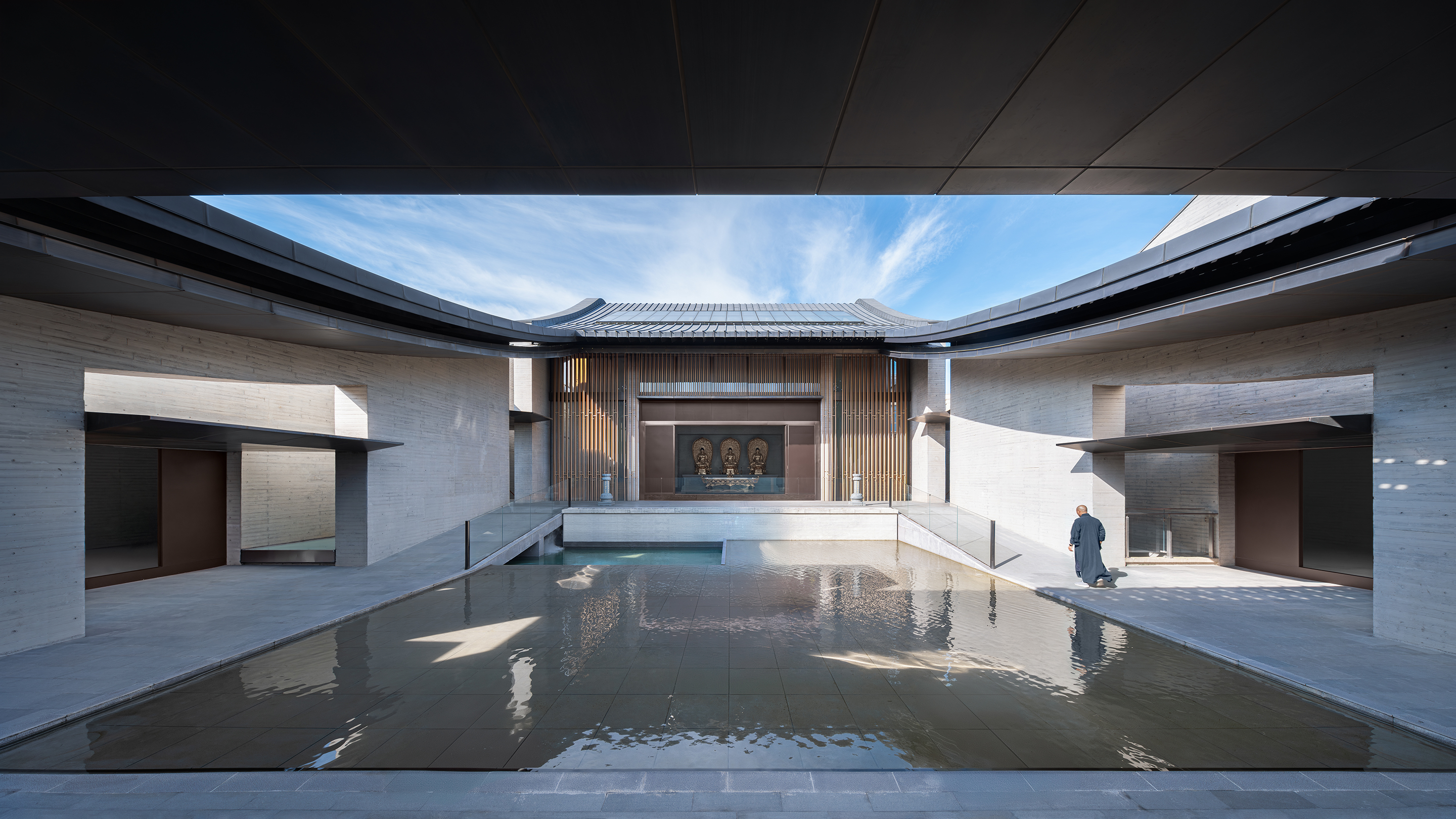
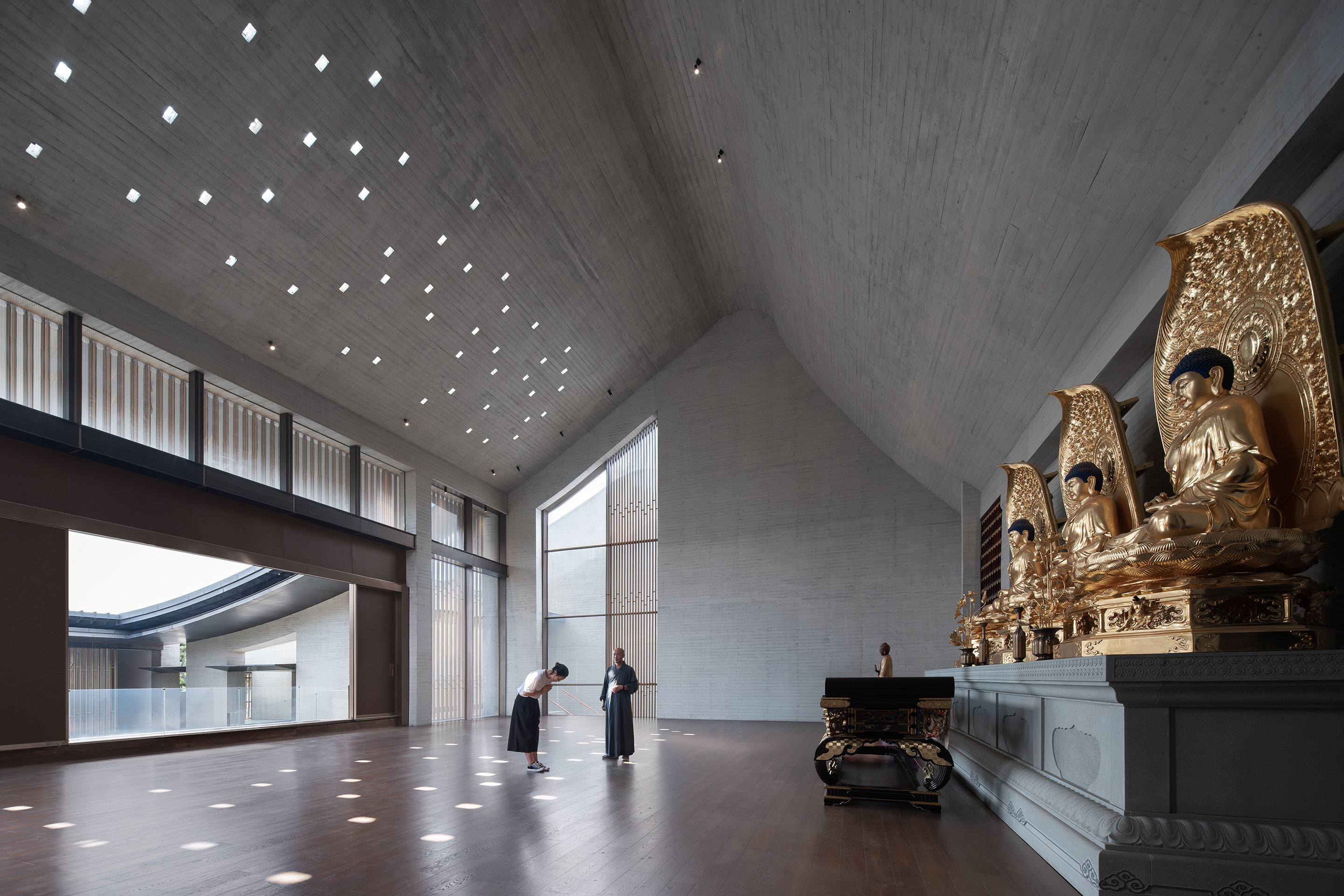
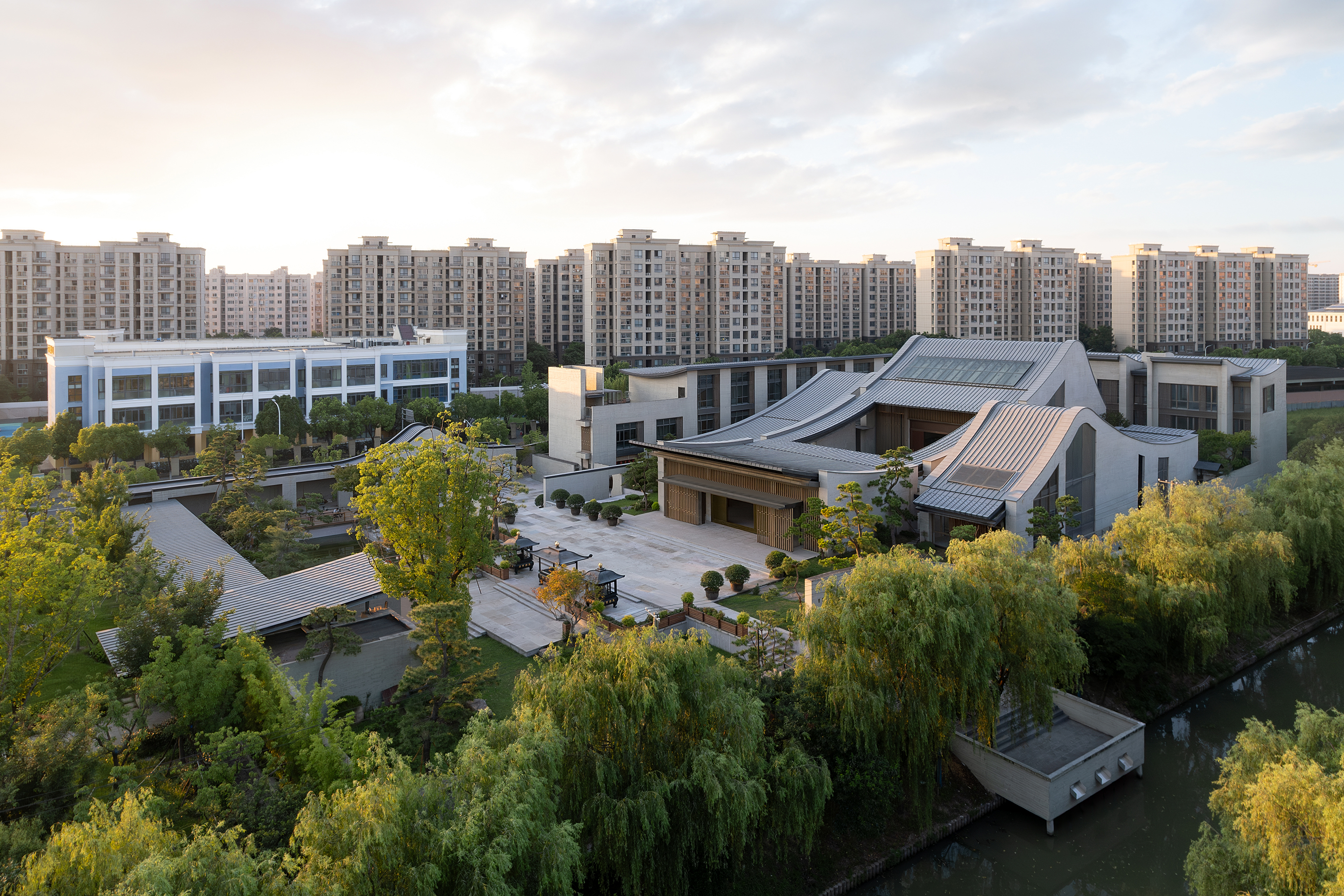
项目名称 上海国庆寺
设计单位 深圳墨泰建筑设计与咨询有限公司
项目地点 上海浦东
建成时间 2024年
撰文 沈驰
上海国庆寺十年的设计和建造是神圣理想与世俗精神共创的过程,这种共创或主动,或被动,或在建筑设计的计划内,或又改变了建筑设计的初衷。
The design and construction process of Shanghai Guoqing Temple over the last decade have been a process of co-creation between sacred ideals and secular spirits. This co-creation has been sometimes proactive, sometimes passive. Sometimes it was within the plan of architectural design, sometimes it changed the original design intentions.
2014年底,我接到朋友的电话,被邀请设计一座寺庙的方案。寺庙不大,有位年轻的住持,法号演因。我在电话里跟他说:“如果您要个传统仿古寺庙,我不适合做,如果您想做个现代寺庙,我很有兴趣。”演因法师说:“我很期待!”于是我们便开始了合作。
In late 2014, I received a phone call from a friend inviting me to design a scheme for a temple. The temple was not large, and there was a young Master with the Dharma name of Yanyin. I told him on the phone, "If you want to build a traditional antiquity-style temple, I would not be suitable. If you want to build a modern one, I would be very interested in designing!" Master Yanyin said, "I look forward to it!" Therefore, our collaboration began.

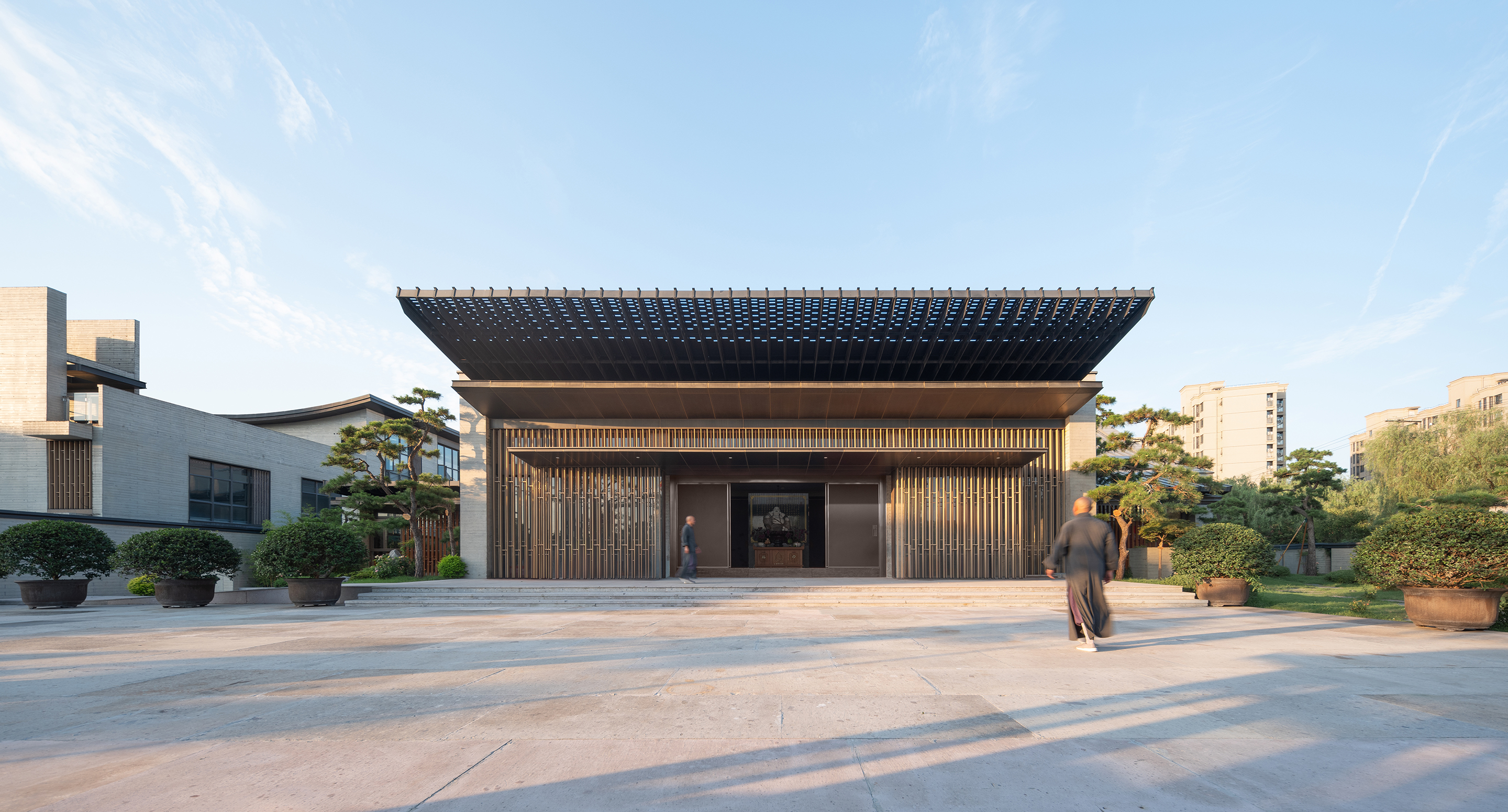
项目位于上海浦东唐镇中心区域,一边临河,两边临路,用地旁有一块城市绿地。原址曾有一座明代寺庙,为纪念明代抗倭名将俞大猷的“俞公祠”。
The project is located in the central area of Tang Town, Pudong District of Shanghai. It bordered by a river on one side and roads on two sides, with an urban green space adjacent to the site. In the plot, there used be the Yu Gong Temple, which was built for commemorating Yu Dayou, a famous anti-invasion warrior in the Ming Dynasty.
当代宗教建筑是个很有意思的设计题目,我们心目中的这座寺庙的设计应体现中国性、禅宗气质和当代精神,并与城市友好。
The design of contemporary religious architectures is a very interesting topic. In our minds, the design of this temple should, while being friendly to the city, embody Chinese characteristics, Zen temperament, and contemporary spirit.

中国性
Chinese Characteristics
“儒释道”是中国传统文化的三大源流,其中的“释”即指佛教,中国的寺庙无法绕开对中国性的回应。
Confucianism, Buddhism, and Taoism are the three main sources of traditional Chinese culture. Chinese temples cannot avoid responding to Chinese characteristics.
我们对中国建筑的理解,是立足以“空间关系”为先,而非“物”为先。中国传统建筑多为一进一进的院落格局,相比西方传统建筑对宏伟之物的追求,中国则更关注建筑与建筑之间“空”的部分。即使用地紧张,这座寺庙也不应该是一座集中的大建筑,而应该是群组建筑,尊重汉传佛教基本格局,创造更多建筑之间的小环境。建筑间有庭院、天井和缝隙,这些户外空间尺度控制的很小,产生一种屏蔽效应,让寺院内基本看不到周围城市的高层住宅,让在城市环抱下的寺院呈现 “幽、隐、静、藏”的气氛!
Our understanding of Chinese architectures is based on giving priority to "spatial relations" rather than "objects". Traditional Chinese architectures are mostly composed of a series of courtyards. Different from the pursuit of grand scale in Western traditional architectures, China pays more attention to the "empty" parts among buildings. Even when the site area is limited, the temple should not be a single large building but a group of buildings, respecting the basic pattern of Han Buddhism while creating more small space among buildings. There are courtyards, patios, and gaps among buildings. These outdoor spaces are controlled to a small scale, producing a shielding effect that makes it basically impossible to see the surrounding urban high-rise residences while staying in the temple. Therefore, it creates an atmosphere of "seclusion, concealment, quietness, and isolation " for the temple while it was surrounded by urban architectures.
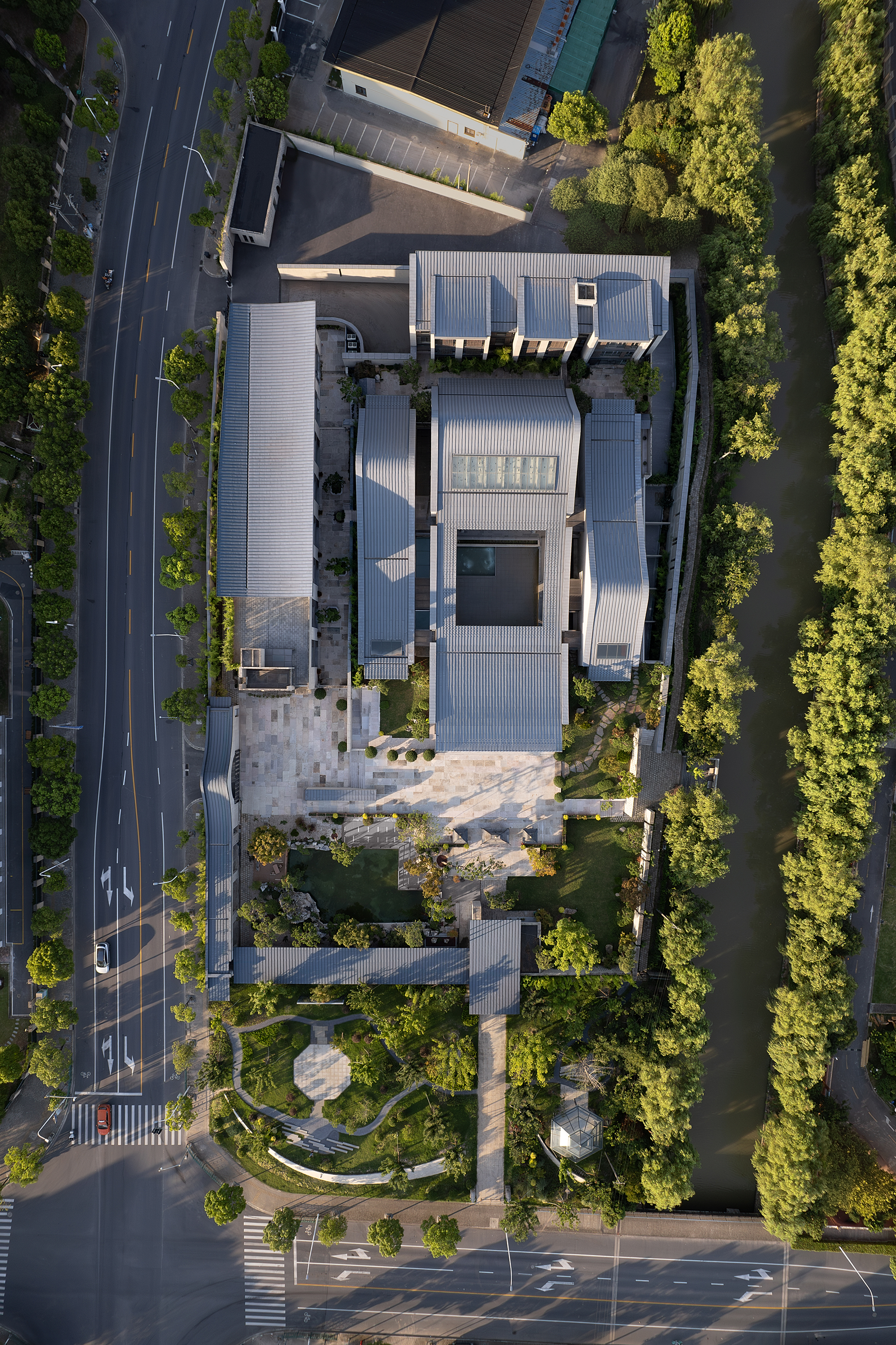
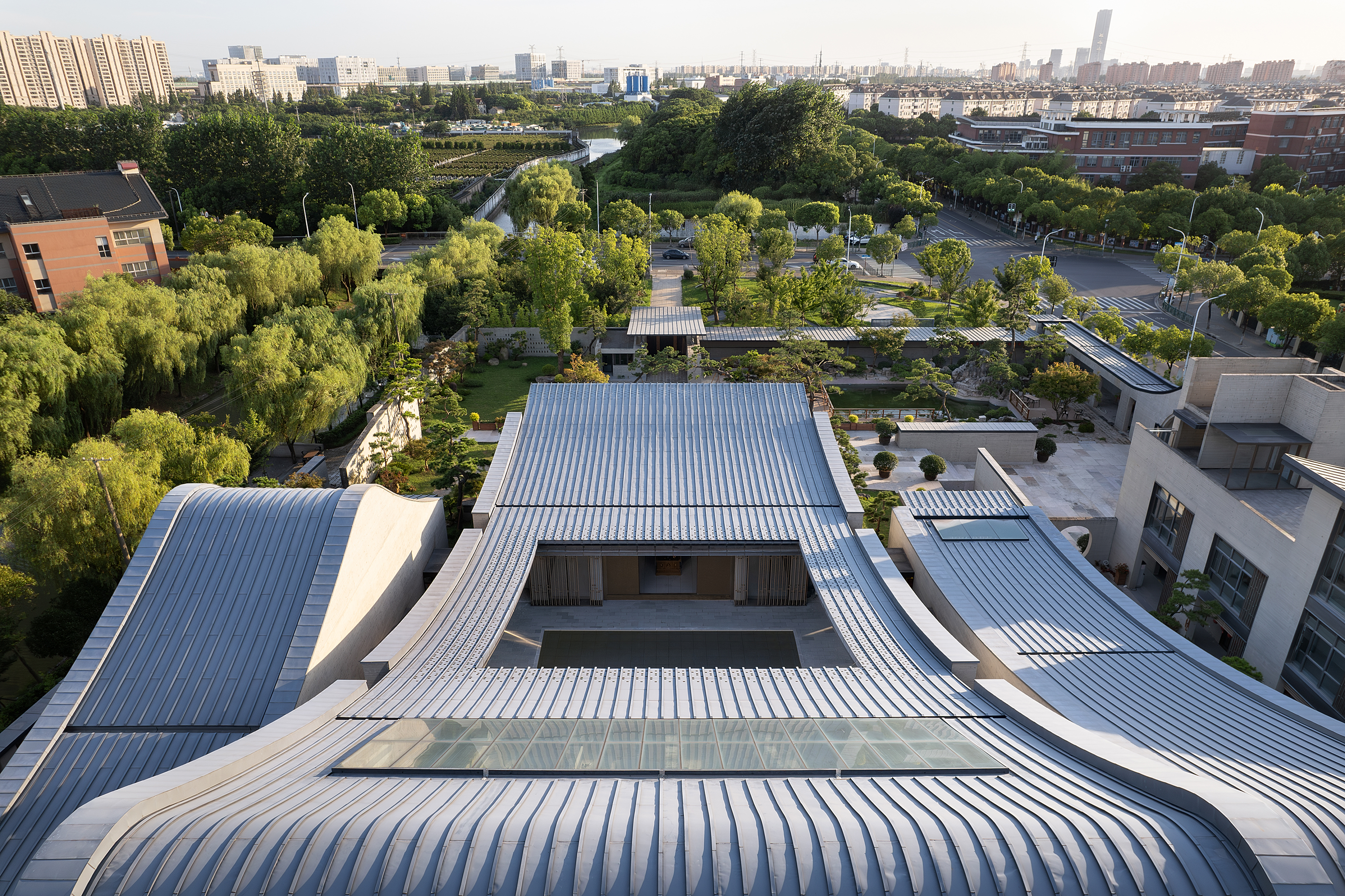
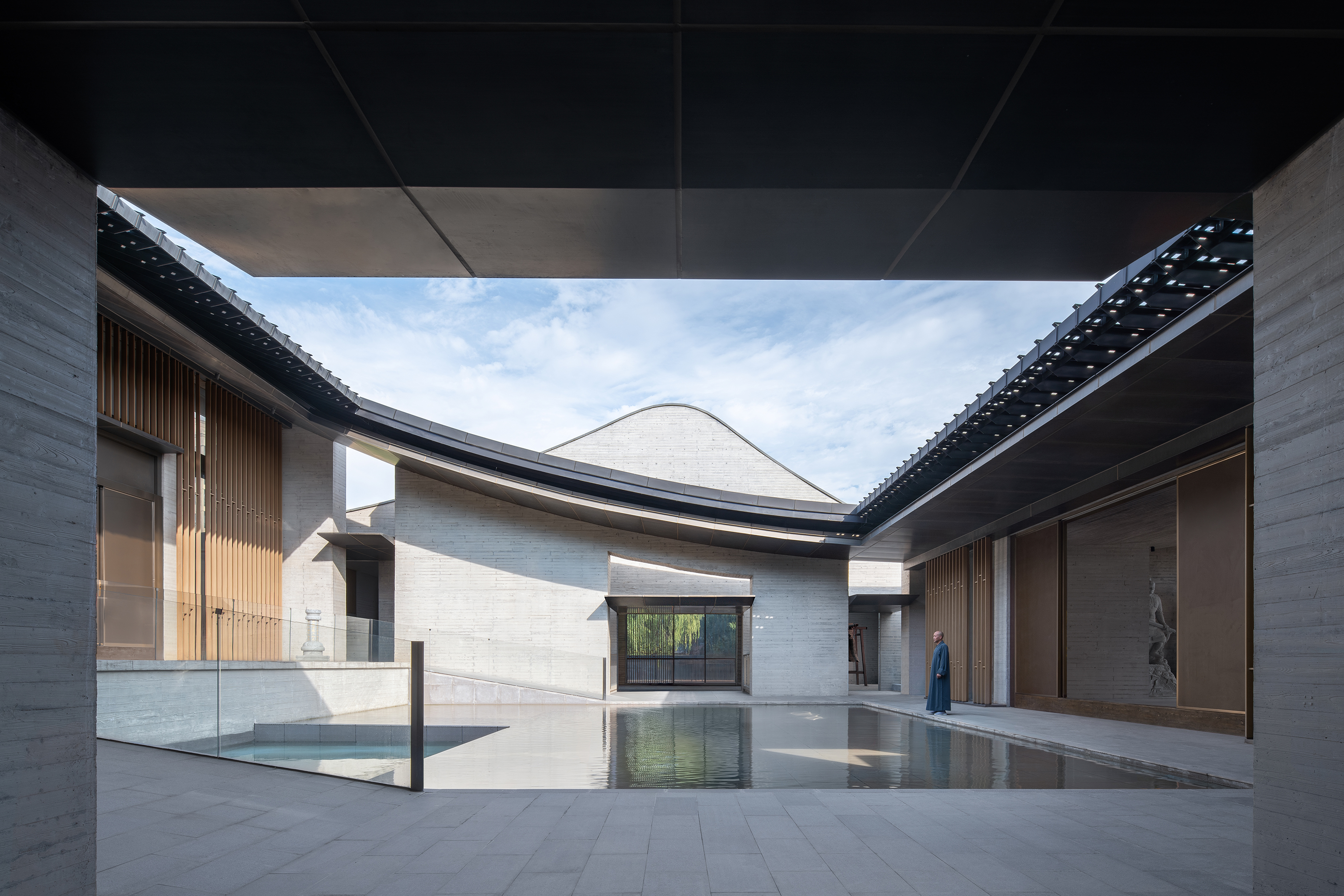

佛殿建筑舒展的屋顶,是在呼应中国建筑的水平伸展的线条。为了这种水平型,地上仅布置佛殿和僧人们居住的场所,最大化减少地上建筑体量。佛堂、图书馆、餐厅、禅修房、停车库等因此被安排在地下,并结合一周的下沉庭院,让半地下空间获得自然通风和采光。
The stretching roof of the Buddhist hall echoes the horizontal stretching lines of Chinese architectures. To achieve this horizontal form, we have to minimize the above-ground building volume. So only the main Buddhist hall and the living space for monks are constructed on the ground. Many space, such as the Buddha room, library, canteen, meditation rooms, parking garage, etc., are arranged below the ground. These underground space are design combined with a sunken courtyard around the perimeter, so as to make the semi-underground spaces to obtain natural ventilation and daylight.


禅宗气质
Zen Temperament
这是一座禅宗寺院,禅宗之美,在于简素,直指人心,见性成佛。
This is a Zen temple, and the beauty of Zen lies in simplicity, directly influencing the human minds, and seeing nature to achieve Buddhahood.
我们使用了木模板的清水混凝土作为主要材料,用厚重朴素的材质呈现禅宗的精神。住持感受到清水混凝土墙的韵味,给它们起了个富有禅意的名字——融素。
Fair-faced concrete with wooden formwork is the main material. It presents the spirit of Zen with a thick and simple texture. Abbot Yanyin felt the charm of the fair-faced concrete walls and gave them a Zen-like name - "Rongsu" (Blended Simplicity).

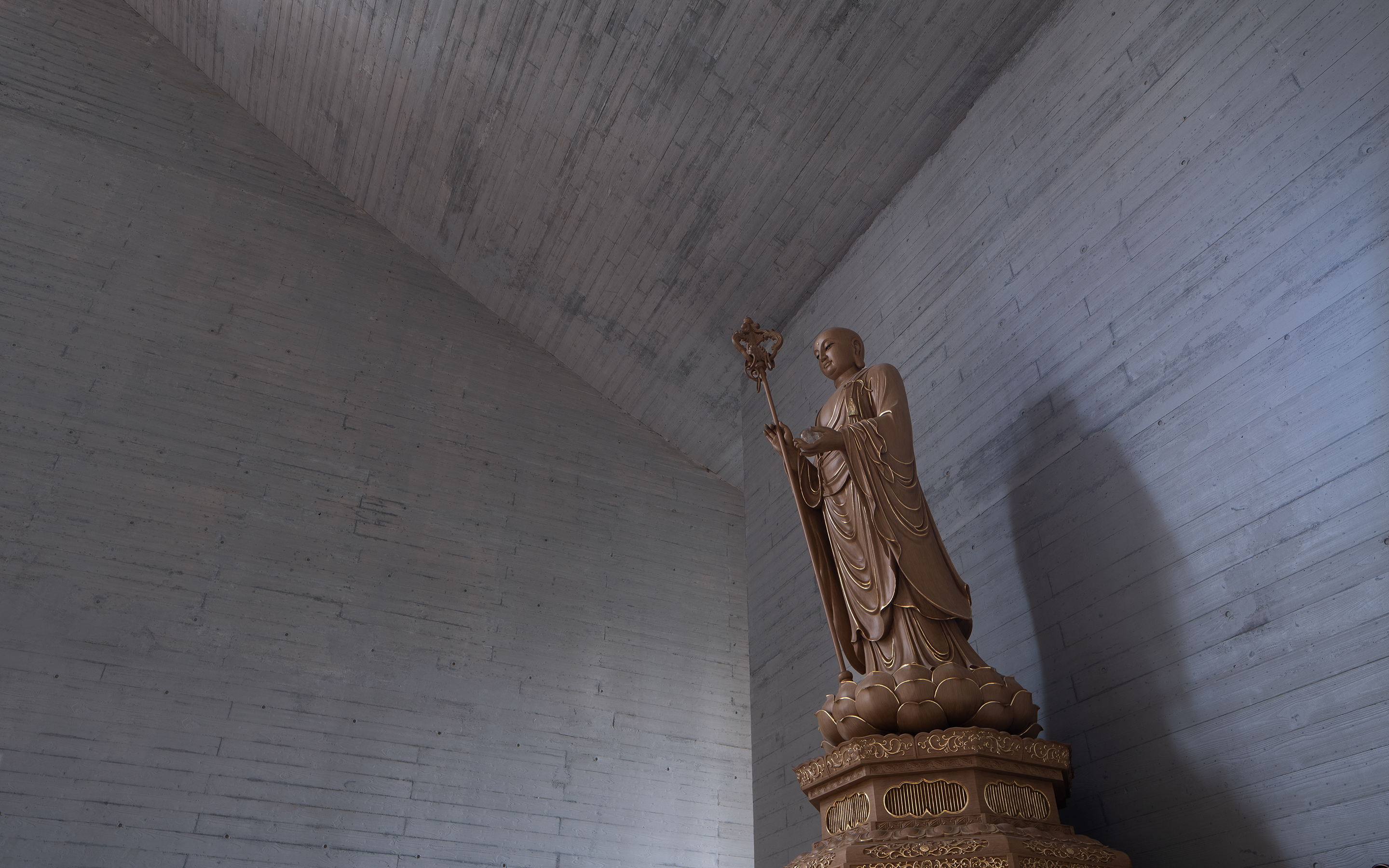
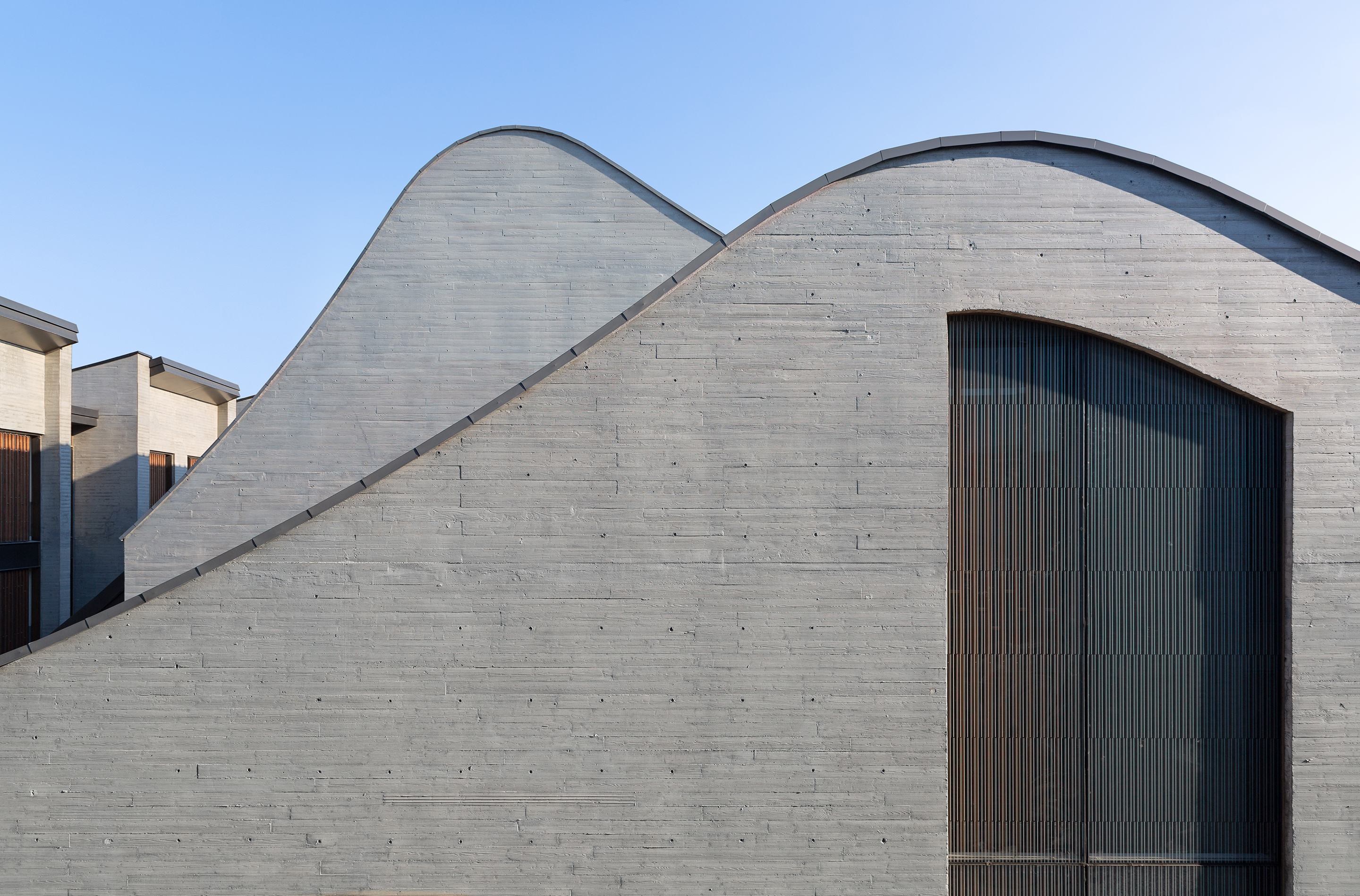
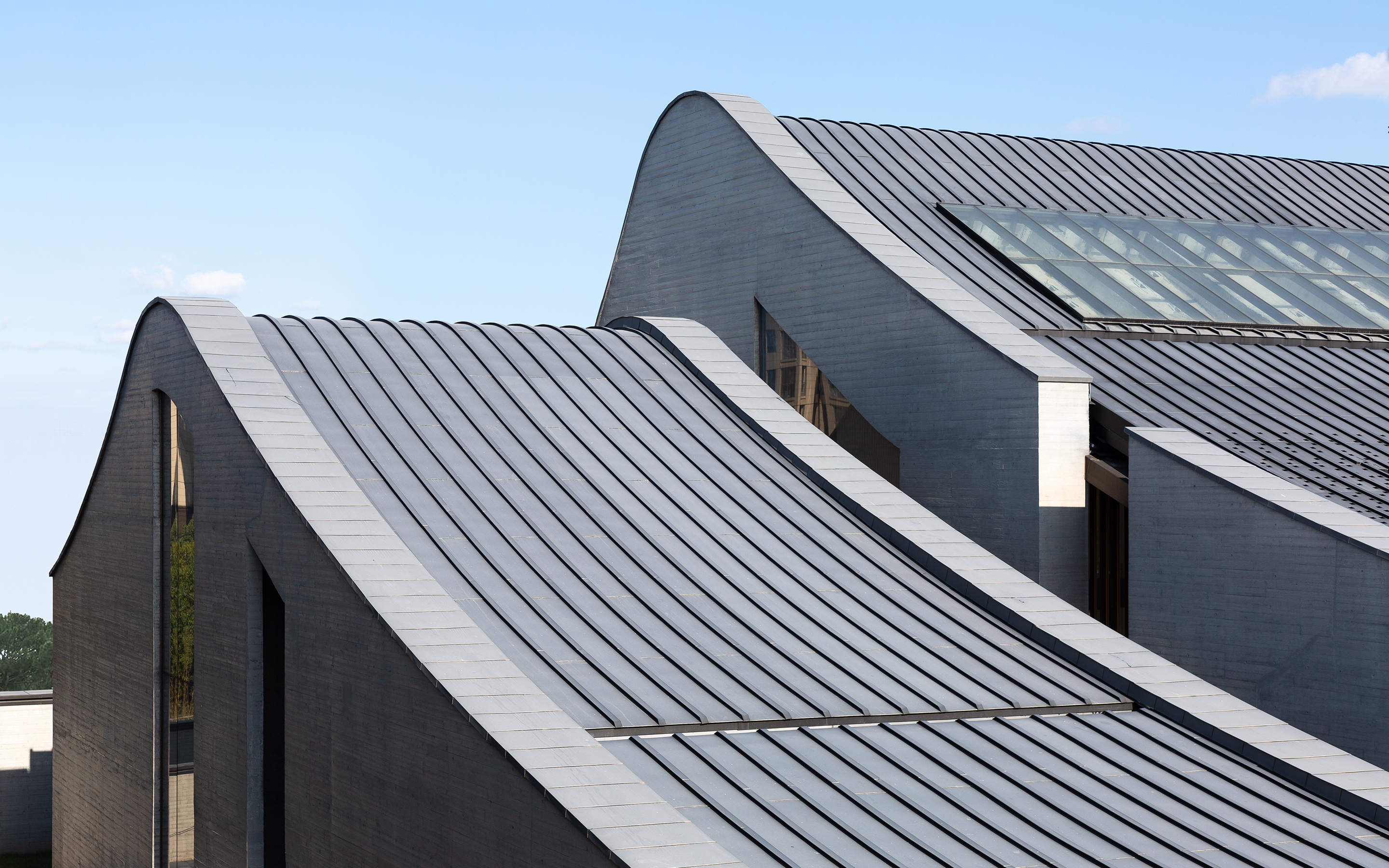
厚墙的建筑间,不时有窄缝和洞口,让不大的空间有着丰富的层次;大雄宝殿前,一片静水面,大殿倒影其中;钛锌板的屋檐上,渐变式的小孔由虚变实,过滤着自然光;大雄宝殿的顶部,散开的孔洞让光斑洒落在大殿内……空间种种,创造出一种“幽明”的气氛,让人忘却尘世的纷繁,在一片精神所在进入佛法的世界。
Among the thick-walled buildings, there are narrow slits and openings, which giving the small space rich layers; in front of the Mahavira Hall, there is a calm water surface reflecting the hall; on the titanium-zinc roof, gradient small holes filtering natural light; the scattered holes on the roof of the Mahavira Hall, allow light spots to appear in the hall... Various spaces create an atmosphere of "dimness and brightness", allowing people to forget the hustle and bustle of the world and enter the world of Dharma.


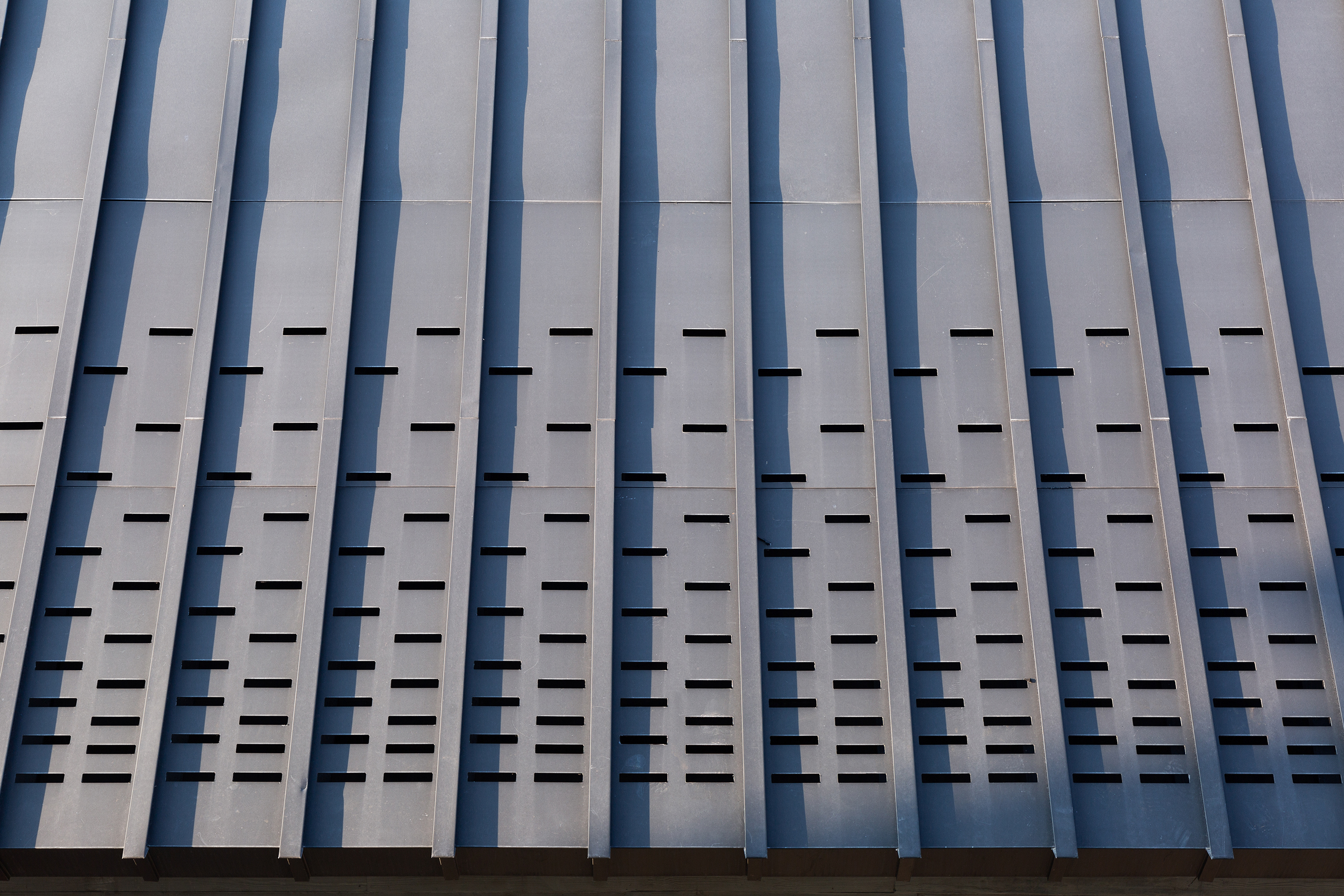

当代精神
Contemporary Spirit
所谓当代建筑,一方面,在于空间、材料等建筑本体的设计。寺庙本身其实没有绝对的式样,汉传佛教把宫廷建筑的格局移植到寺庙中(“寺”在过去指官衙),所以我们有了与藏传、南传、日式等不同的中轴对称官衙式寺庙,并在历朝历代不断演变。
On the one hand, the so-called contemporary architectures lies in the design of the architectural noumenon, such as space and materials. In fact, there is no absolute style for temples. Han Buddhism transplanted the pattern of imperial palace architecture into temples ("temple" used to refer to Yamun, a kind of government agency), so we have central-axis symmetrical Yamun-style temples, which are different from Tibetan, Theravada, and Japanese Buddhist architectures. Temple architecture has been evolving through the dynasties.
我们认为,今天的佛寺应该与时俱进,呈现当代的建筑技术和空间理念,在熟悉与陌生之间体现传承与创新。设计通过建筑的开合处理、庭院尺度的控制,去除了装腔作势的形态。建筑平和朴素,用现代的语言塑造传统韵味和空间精神。
We believe that today's Buddhist temples should keep pace with the times, presenting contemporary architectural technologies and spatial concepts, reflecting inheritance and innovation between familiarity and unfamiliarity. With careful arrangement of the architectural fragmentation and combination, and the control of the courtyard dimensions, the architectures are peaceful and simple with relaxed and natural space. Our design uses modern techniques to create traditional charm and space spirit.
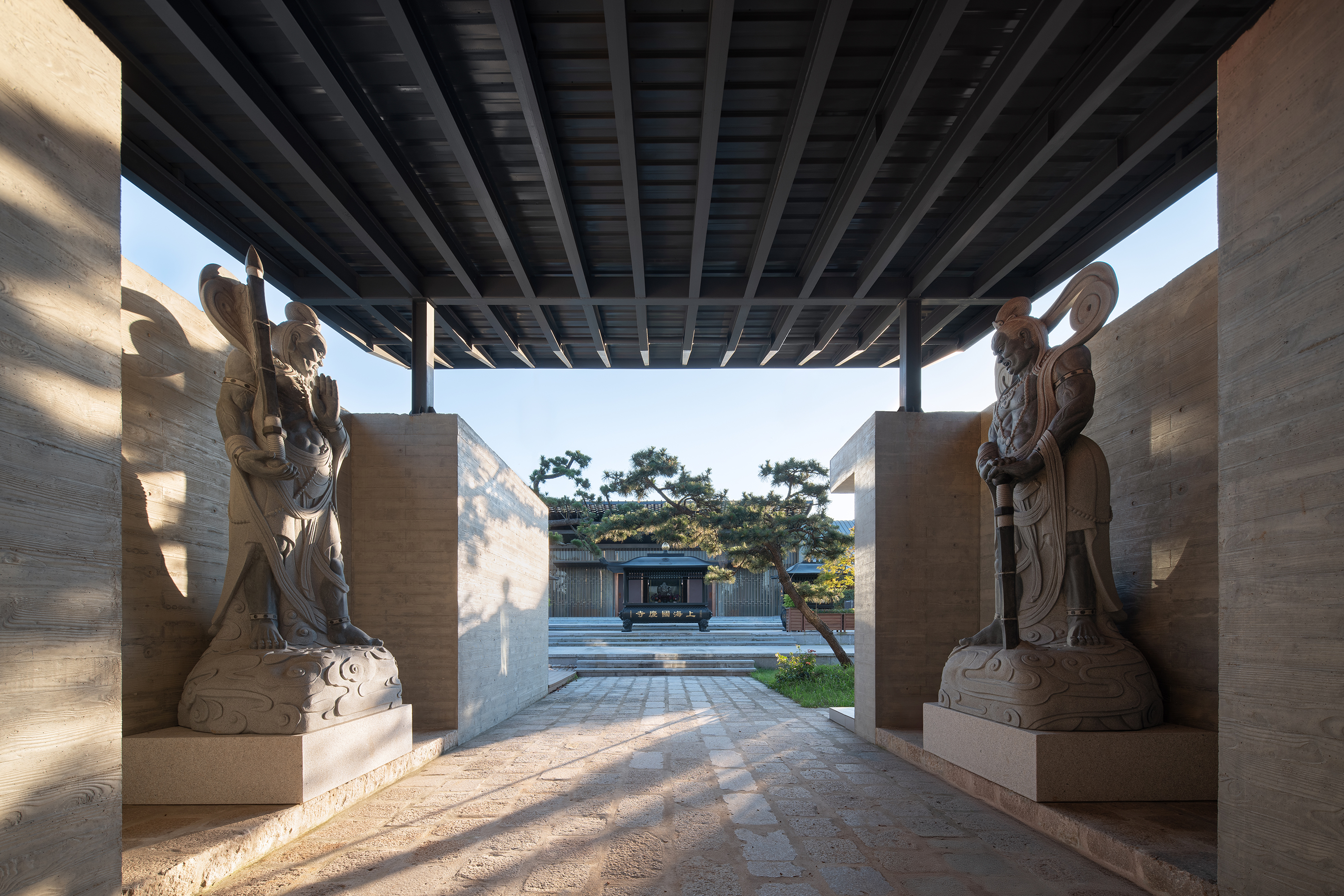

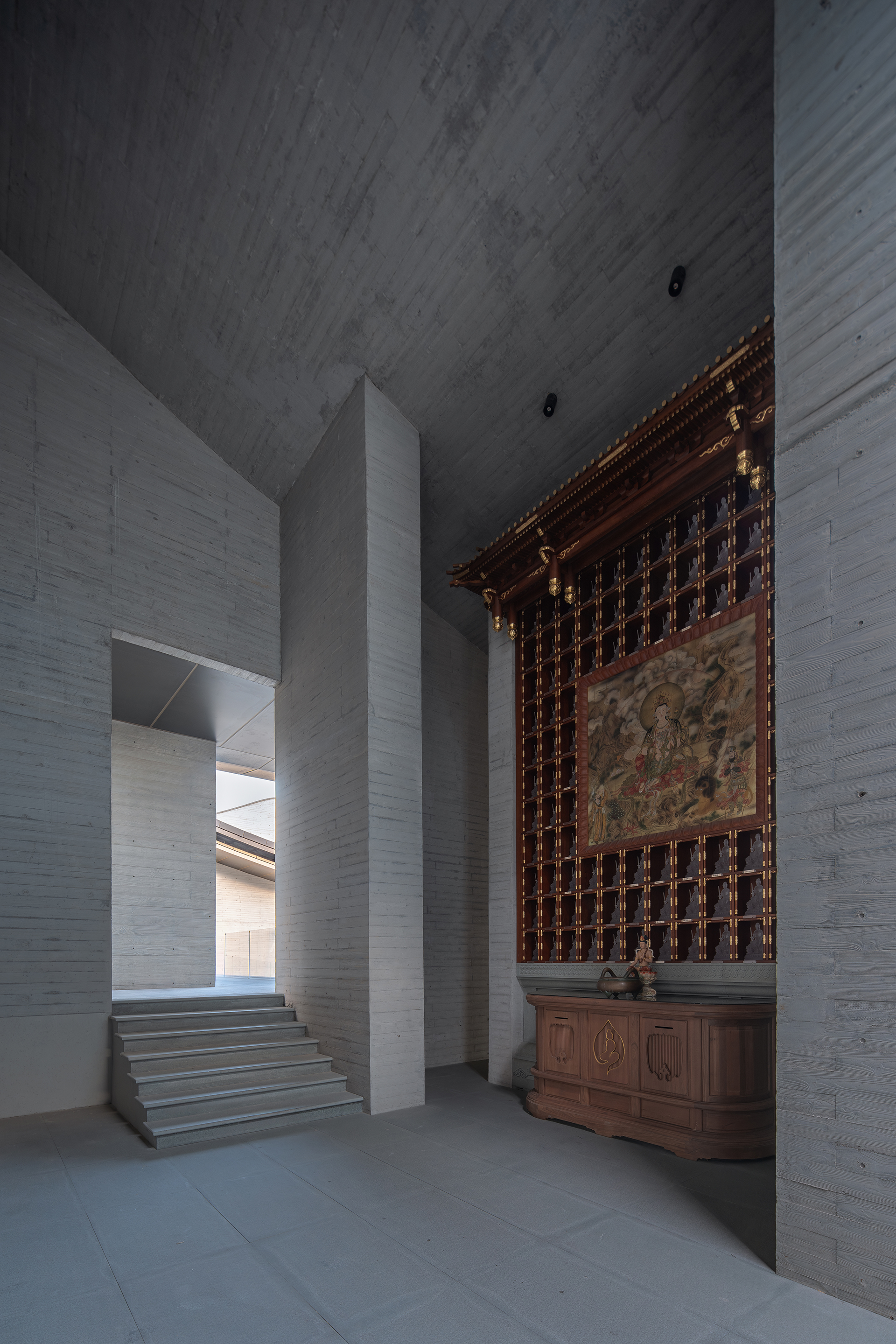
当代精神的另一方面在于建筑与城市的关系。在我们心目中,寺庙也是城市里的文化场所,应体现一定的公共属性。我们通过与政府协商,把寺庙的朝向转至与小绿地连通的方向,寺庙可以封闭,城市公园开放,两者一并设计,连接共享。我们因此还给寺庙和公园取了个共同的名字——众生禅院。
On the other hand, the contemporary spirit lies in the relations between the building and the city. In our minds, the temple is also a cultural place in the city and should reflect a certain public attribute. Through communication with the government, we changed the orientation of the temple to make it better connects to the small green space. The temple can be isolated, but the urban park is open, with the two sites connected and designed together, both of them could be better. We gave the temple and the park a common name - " The Zen Park of All Living Beings".
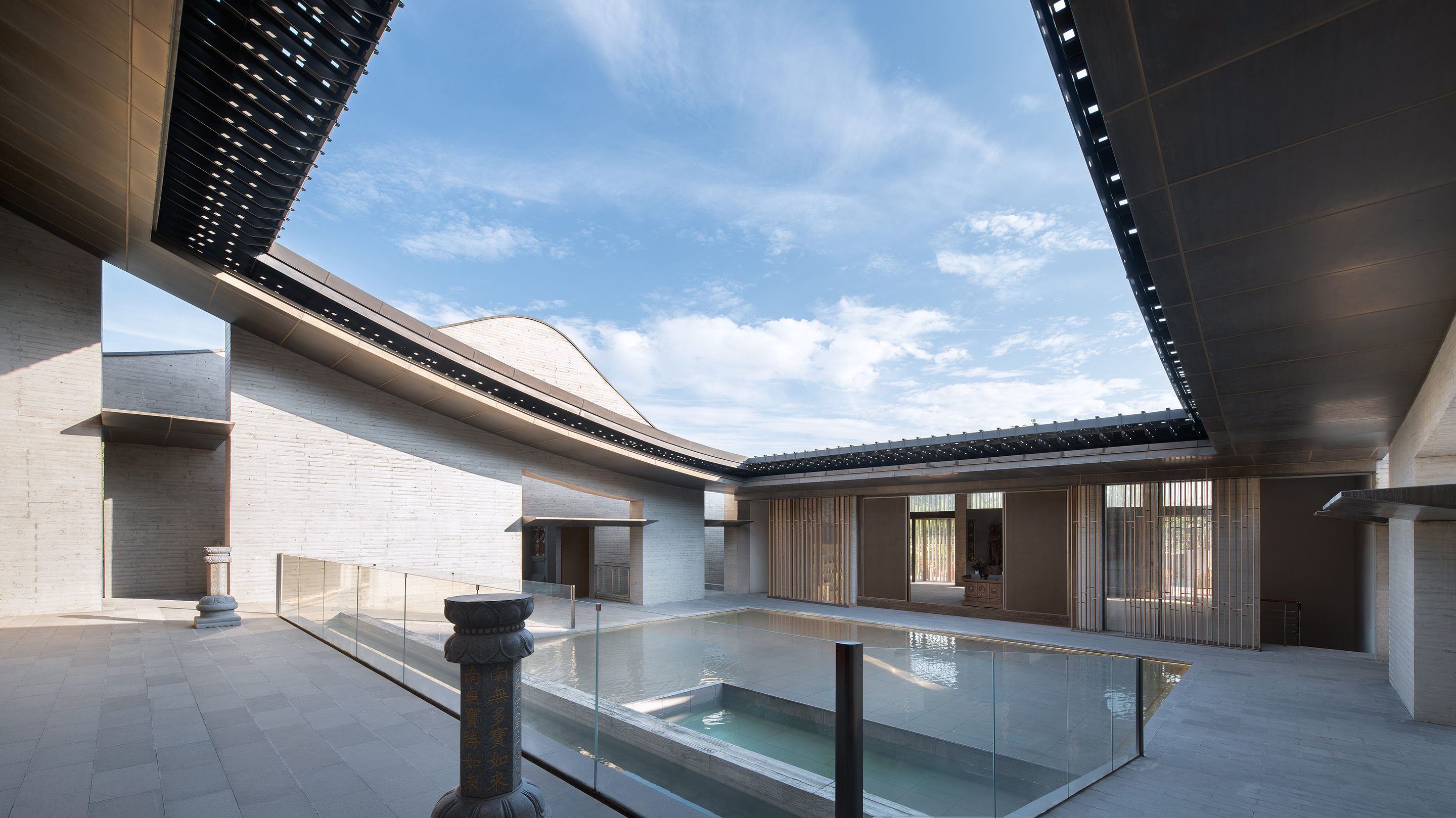
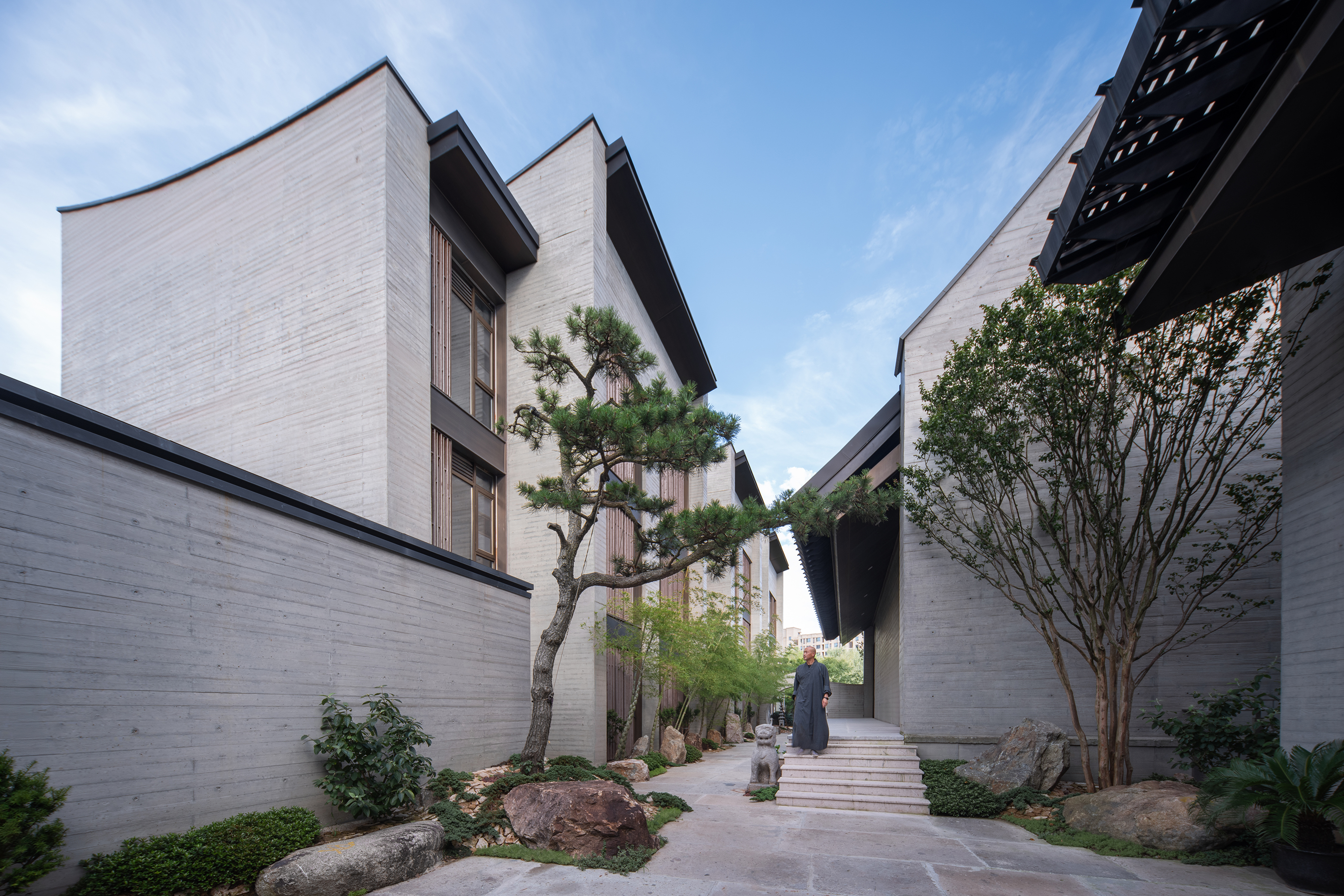
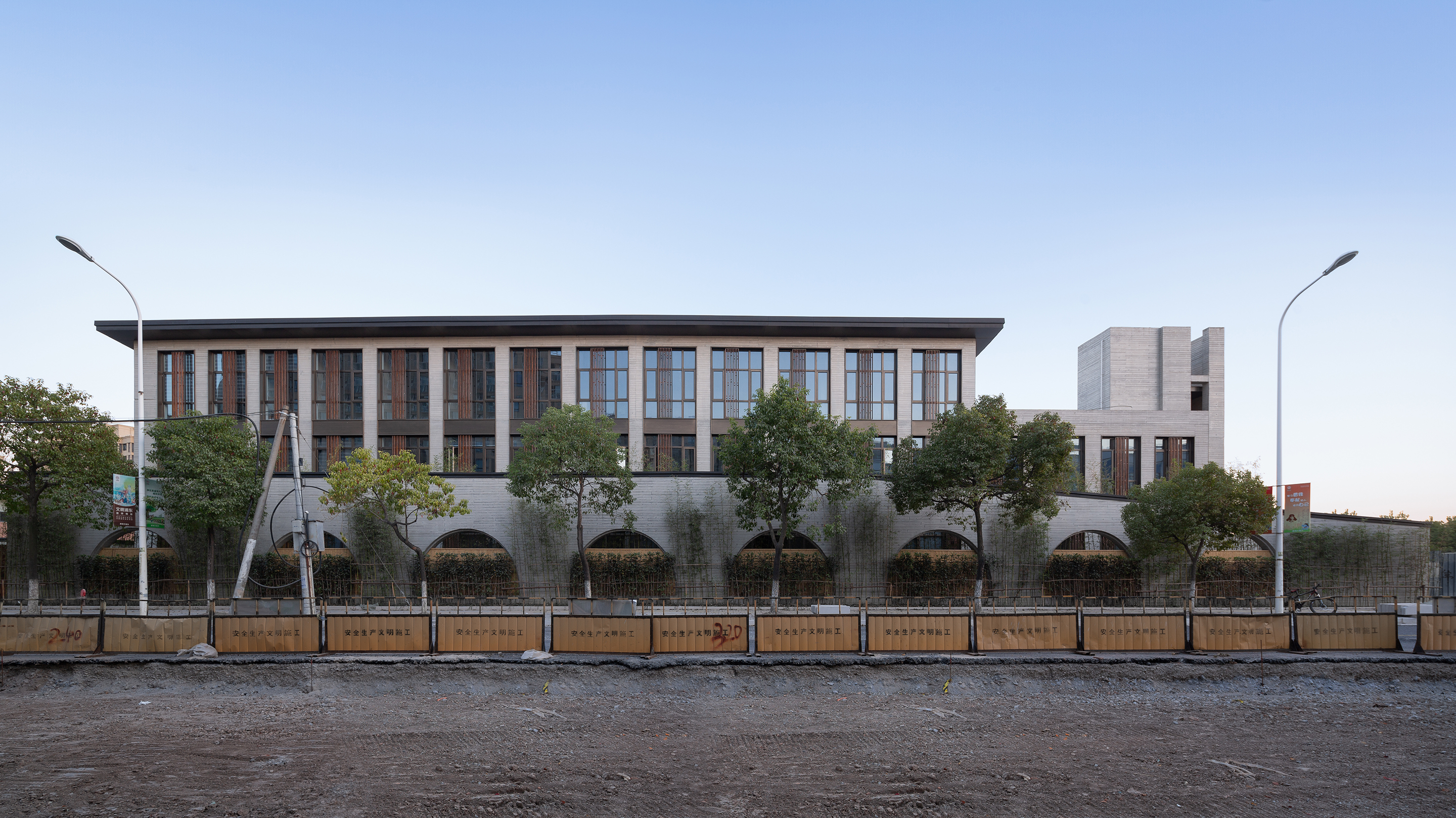

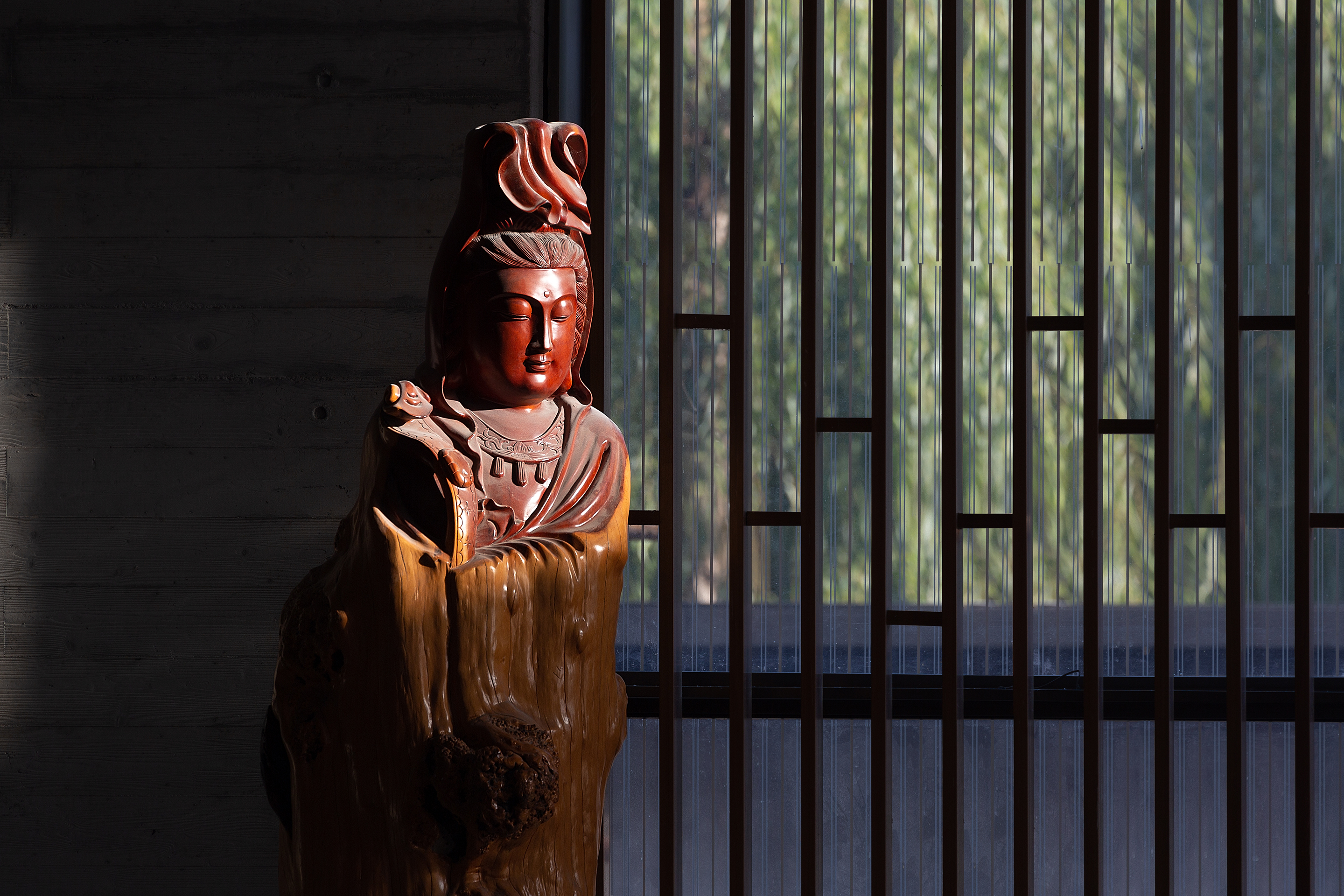
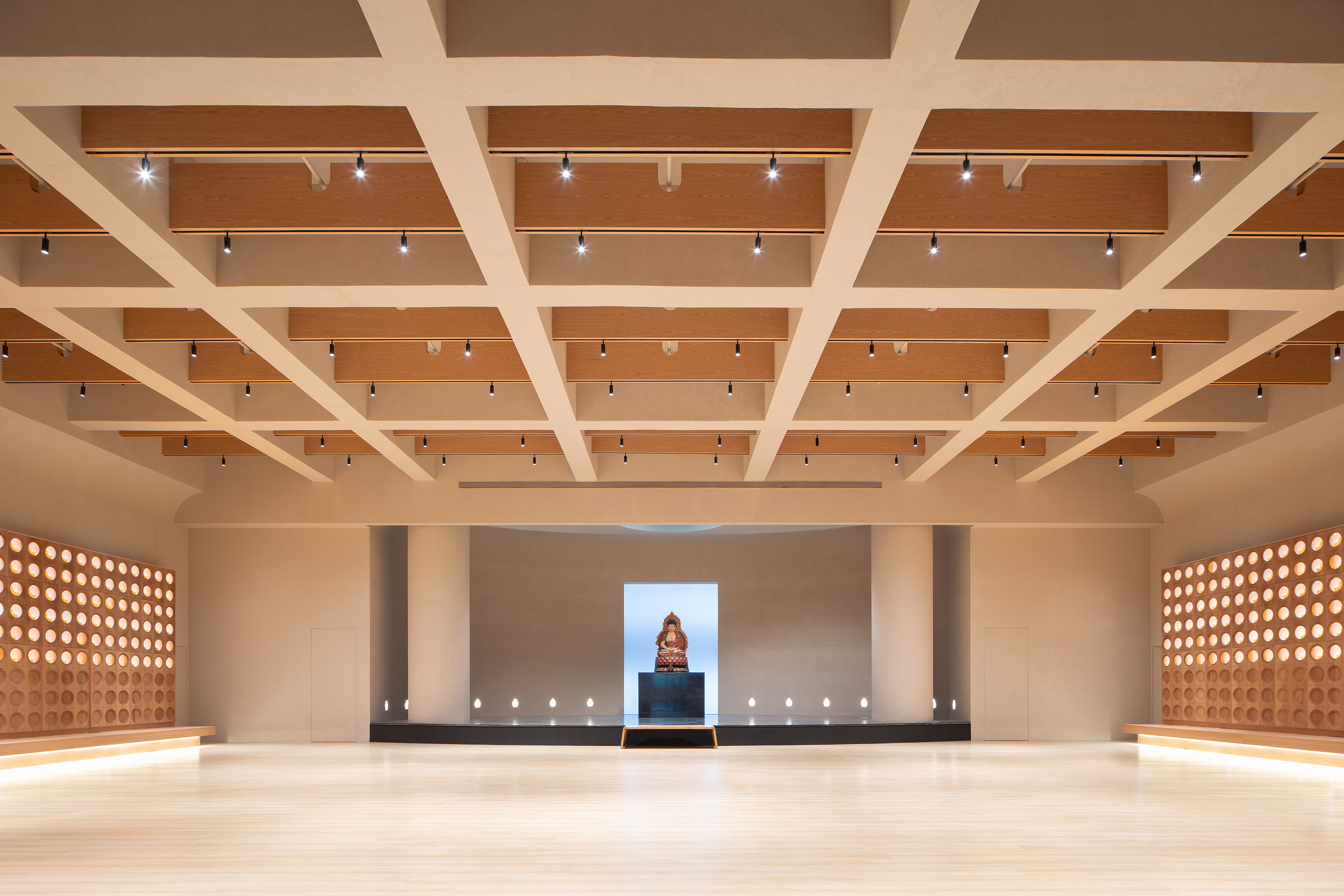
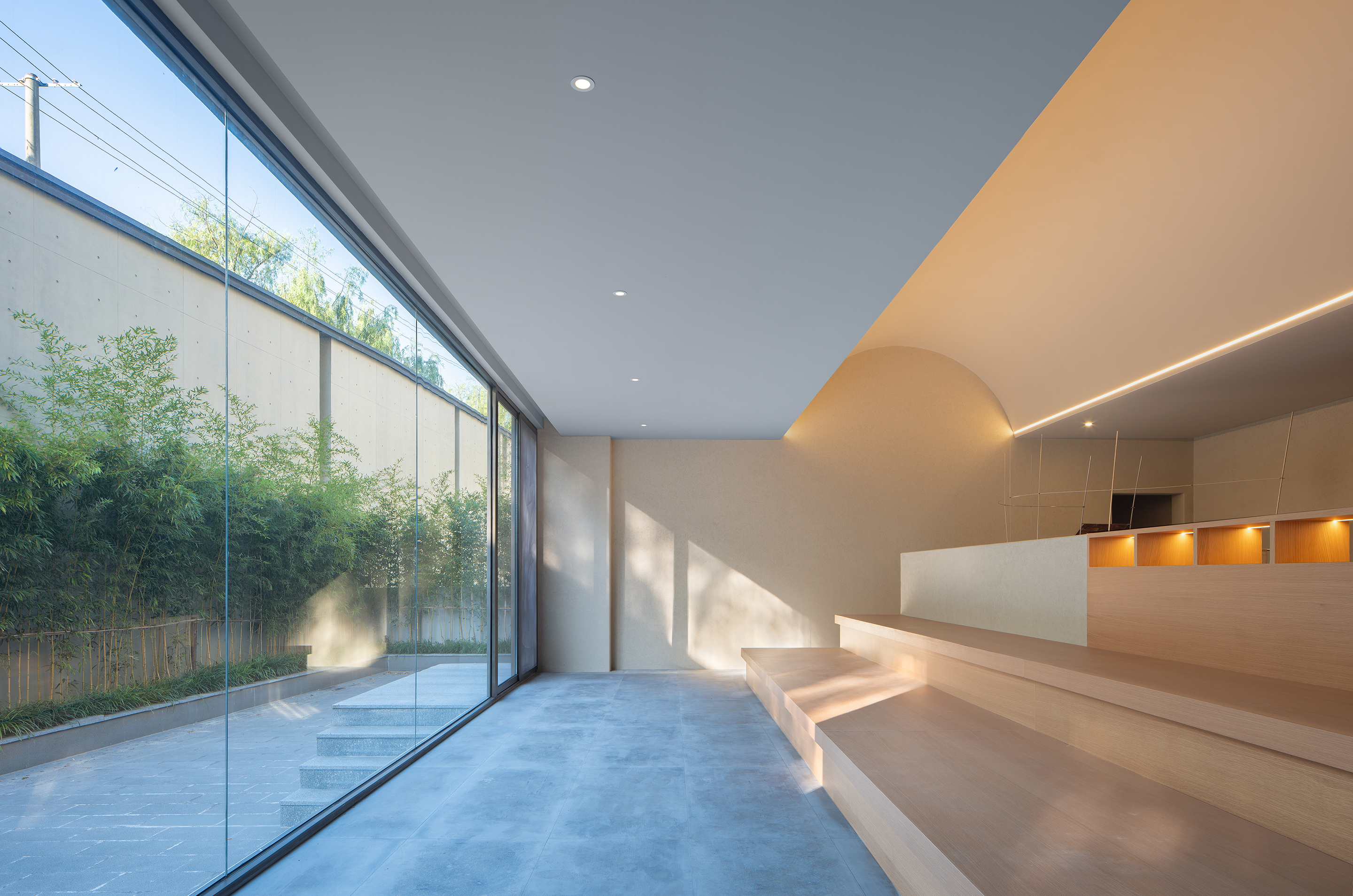
寺庙建设至今已历经十年,命运多舛。
The construction of the temple has last for ten years, and its process has been full of ups and downs.
西南面的城市绿地与寺庙的衔接方式多次沟通变动,我们设计的一组景观构筑物最终被大幅简化,让主建筑群失去了配角,寺庙与城市公园联通的开放格局没能完全实现;大殿周围的配套用房在建设过程中被加高了层数,让主殿从侧面街道无法被看见;大雄宝殿顶部的光孔被取消了大半;一些材料在实施中因种种原因呈现的质量不一致等等。
The connection between the urban green space in the southwest and the temple has been changed many times. A group of structures we designed in the garden was greatly simplified at last, making the main building complex lose its supporting role. Therefore, the open layout connecting the temple and the urban park was not fully realized. The floors of associated rooms around the main hall were increased during the construction process, making the main hall invisible from the side streets. Many light holes on the roof of the Mahavira Hall were canceled. The quality of some materials were inconsistently during construction process due to various reasons, and so on.

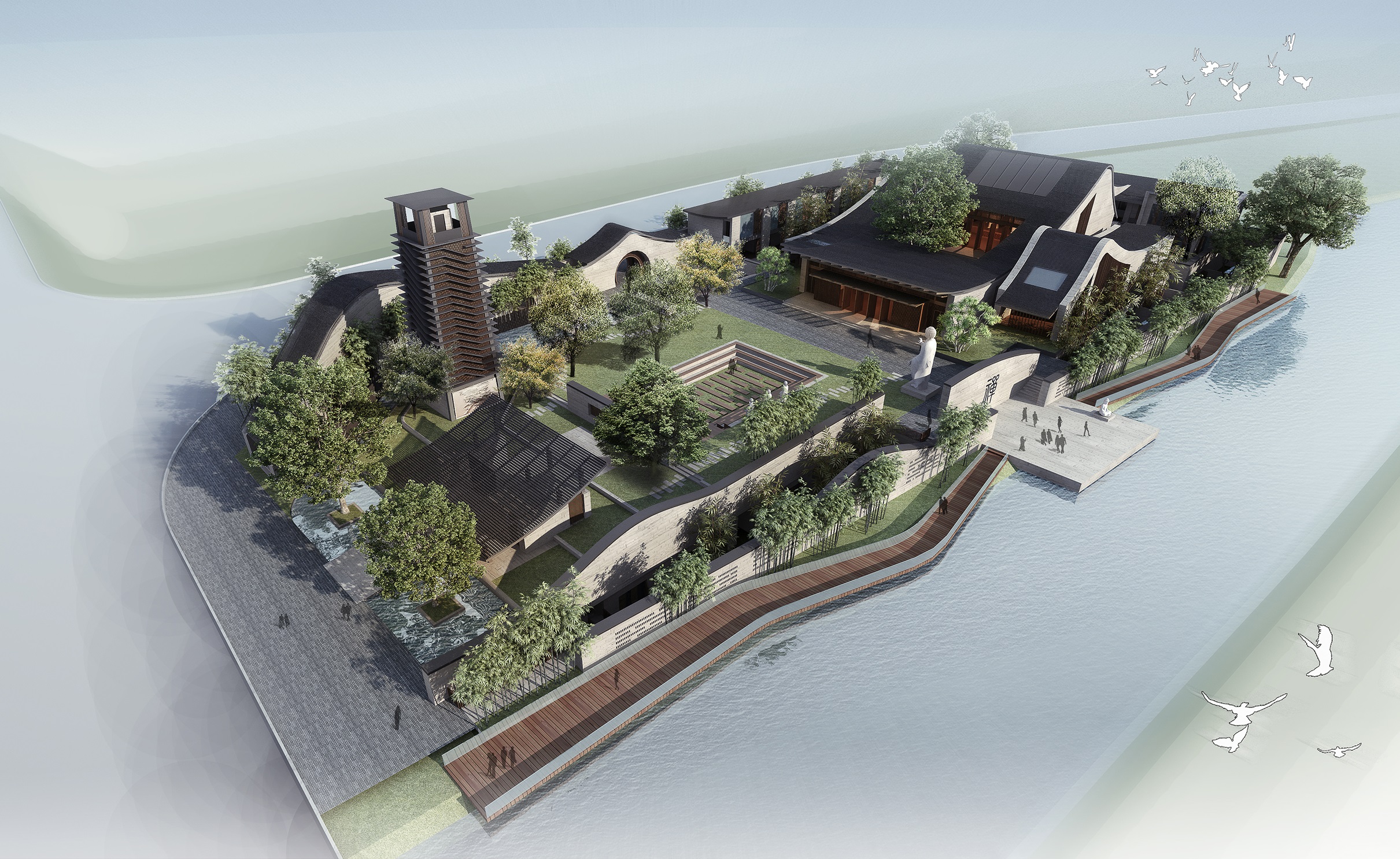
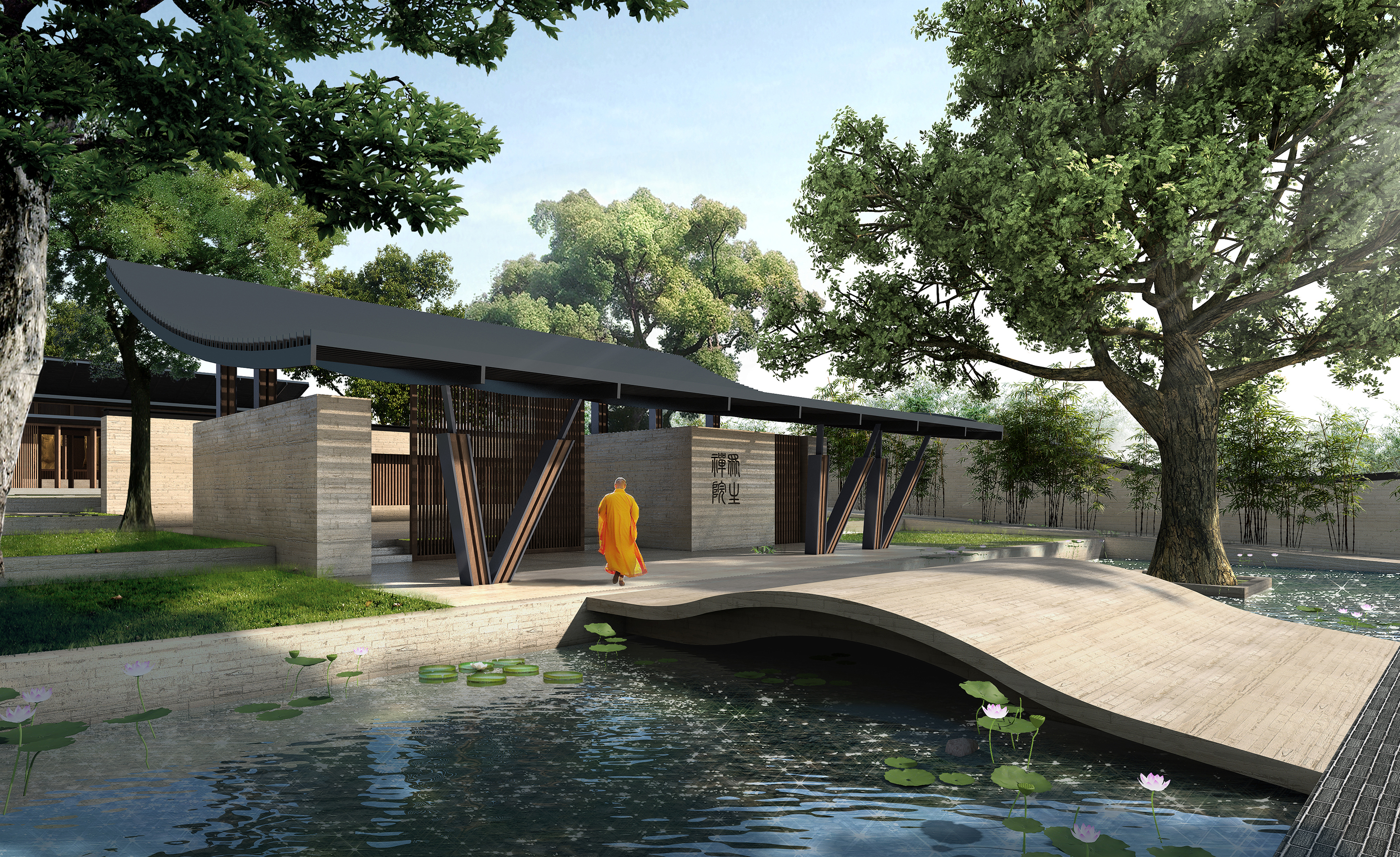
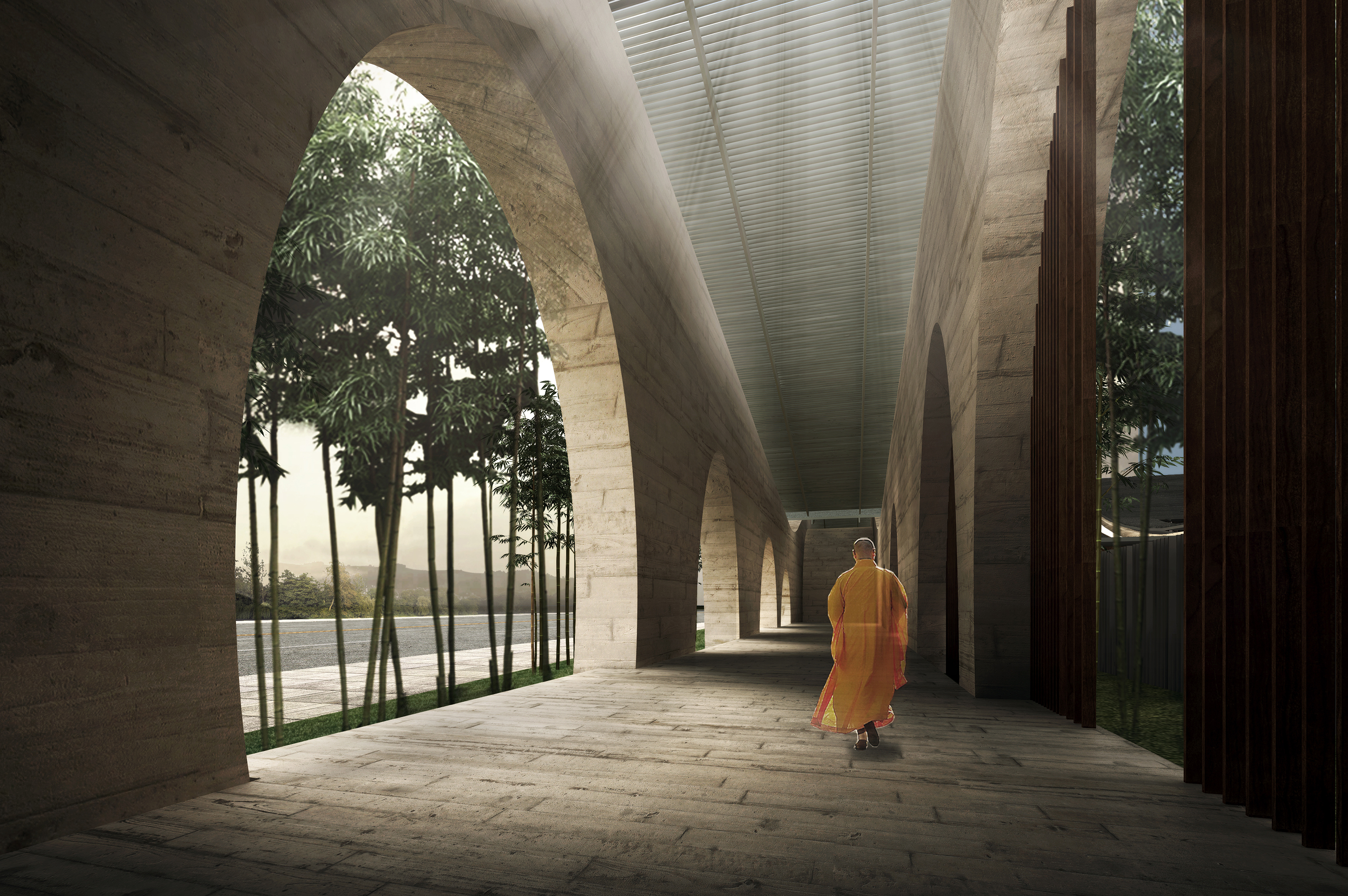
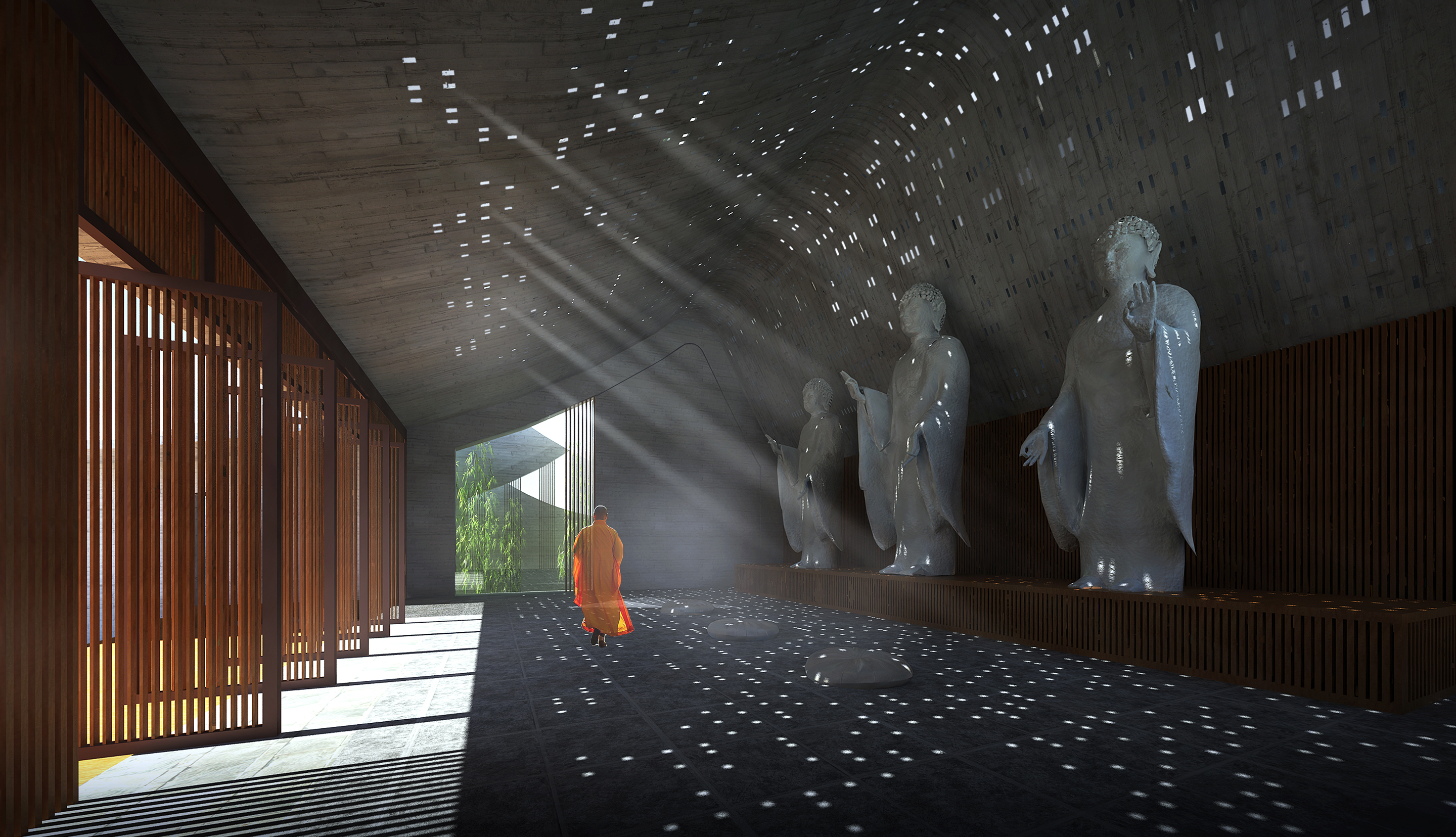
土建完工后,景观、室内、陈设因为资金问题和自由捐赠问题进入了失控状态。寺庙的很多装修和摆设都来自信众的自由捐赠,以至于佛像、栏杆、门、许多陈设的风格代表着不同捐赠者的喜好……寺庙已成为一座众人共创的建筑。
After the main construction was completed, the landscape, interior, and furnishings entered an out-of-control state due to financial problems and free donations. Many decorations and furnishings in the temple came from the free donations of believers, so that the styles of many furnishings, such as Buddha statues, railings, and doors, represent the preferences of different donors. The temple had become a building co-created by many people.
建设的资金大都来自捐赠,有一点做一点。在西方,基督教堂可以建造几百年,比如170多年建造的圣加大教堂、600多年建造的米兰大教堂;在东方,日本禅师升也俊明把造园当作修行,日复一日。
Since most of the construction funds came from donations, we did what we could with the limited funds. In the West, Christian churches could be built for hundreds of years, such as the Sagrada Família built for more than 170 years and the Milan Cathedral built for more than 600 years; in the East, Japanese Zen master Shoye Junmyo regards garden construction as a practice day after day.
上海国庆寺历经十年,其实还有很多地方未完成,也不知何时能完全呈现。但建筑早已投入使用,演因法师在建设过程中就已入住,一步步参与寺庙的建设。当建筑师面对项目不可知的未来,接受了神圣理想与世俗现实的共存,做设计也是一种修行。
After ten years of construction, Shanghai Guoqing Temple still has many unfinished parts. It is unclear when it will be fully presented, though it has already been put into use. Master Yanyin moved in during the construction process and participated in the construction of the temple step by step. Achitects accepted the coexistence of sacred ideals and secular reality when facing the unpredictable future of a project. Doing design is also a kind of practice itself!
多年前,一个友人看到这座庙的设计方案,提笔赠予诗句:“灵心自觉闹市说禅语,江山怀远大隐闻枕涛”,意境与我们的设计思考很贴切。若干年后,项目落成,希望未能辜负初心。
Many years ago, a friend saw the design scheme of this temple and wrote a poem: "The spiritual heart consciously speaks Zen words in the busy city, and the great hermit hears the sound of the waves with the ambition of the country." The artistic conception is very close to our design concept. when the project is completed after several years, we hope we have lived up to our original intention!

设计图纸 ▽
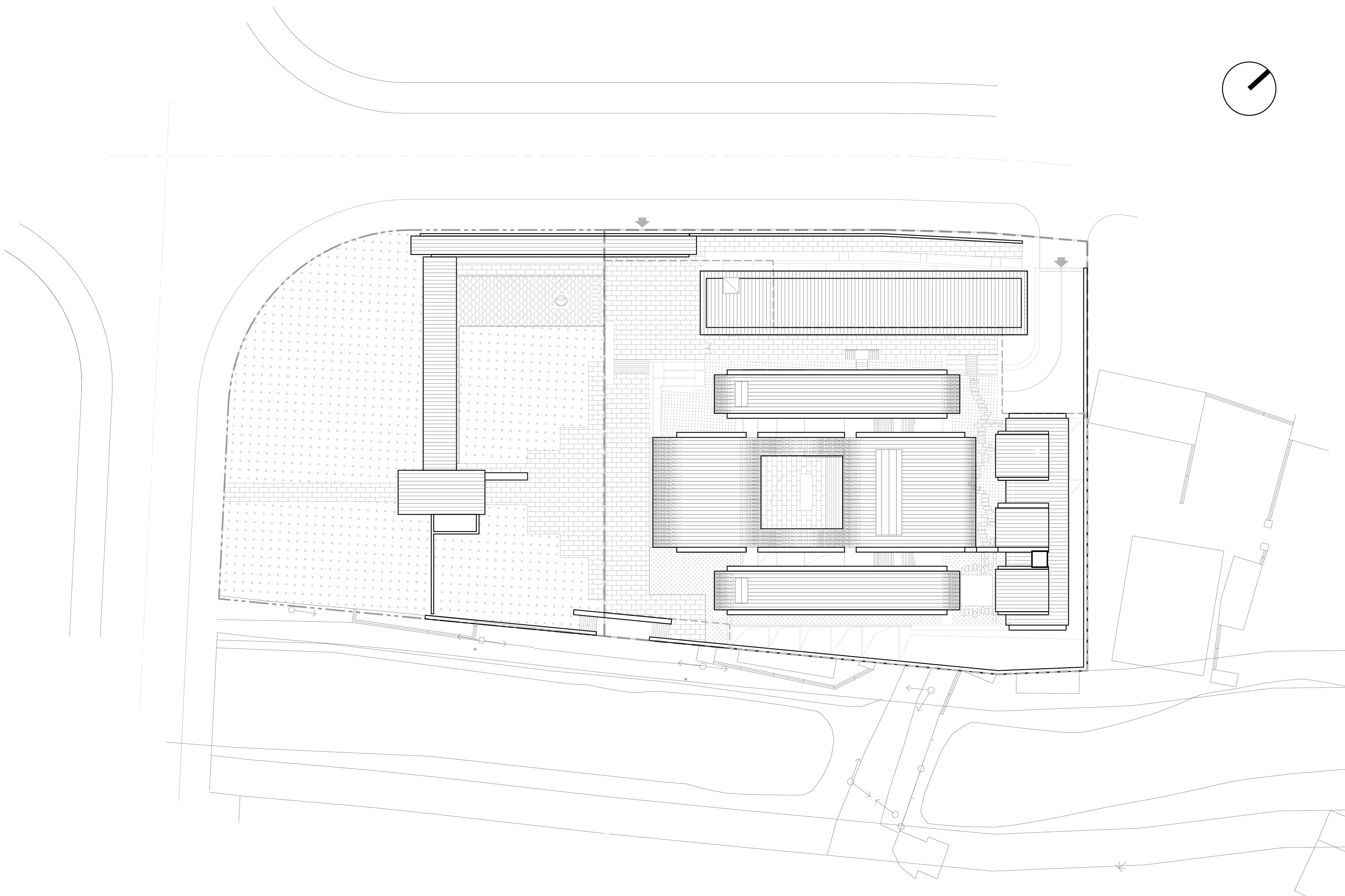
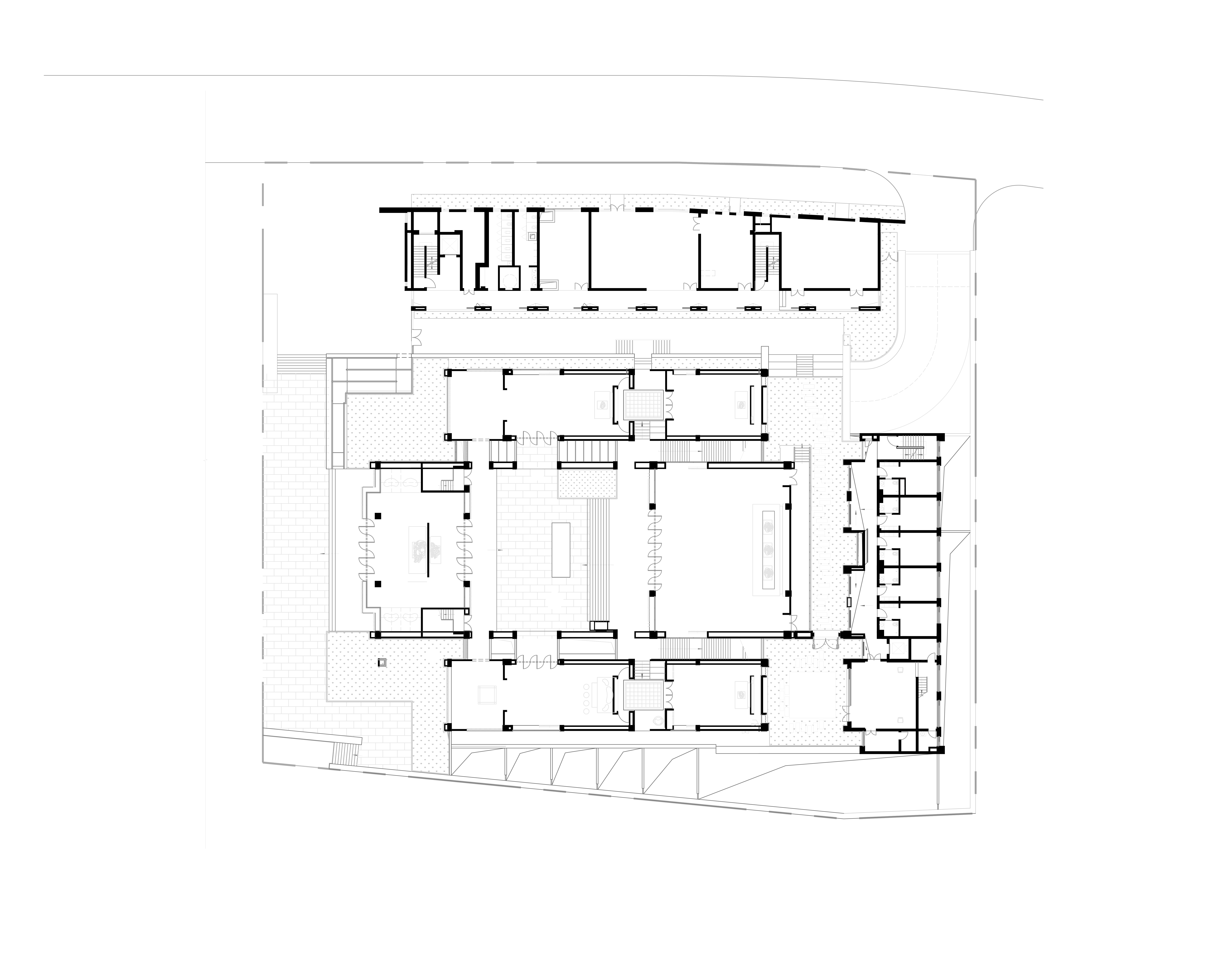
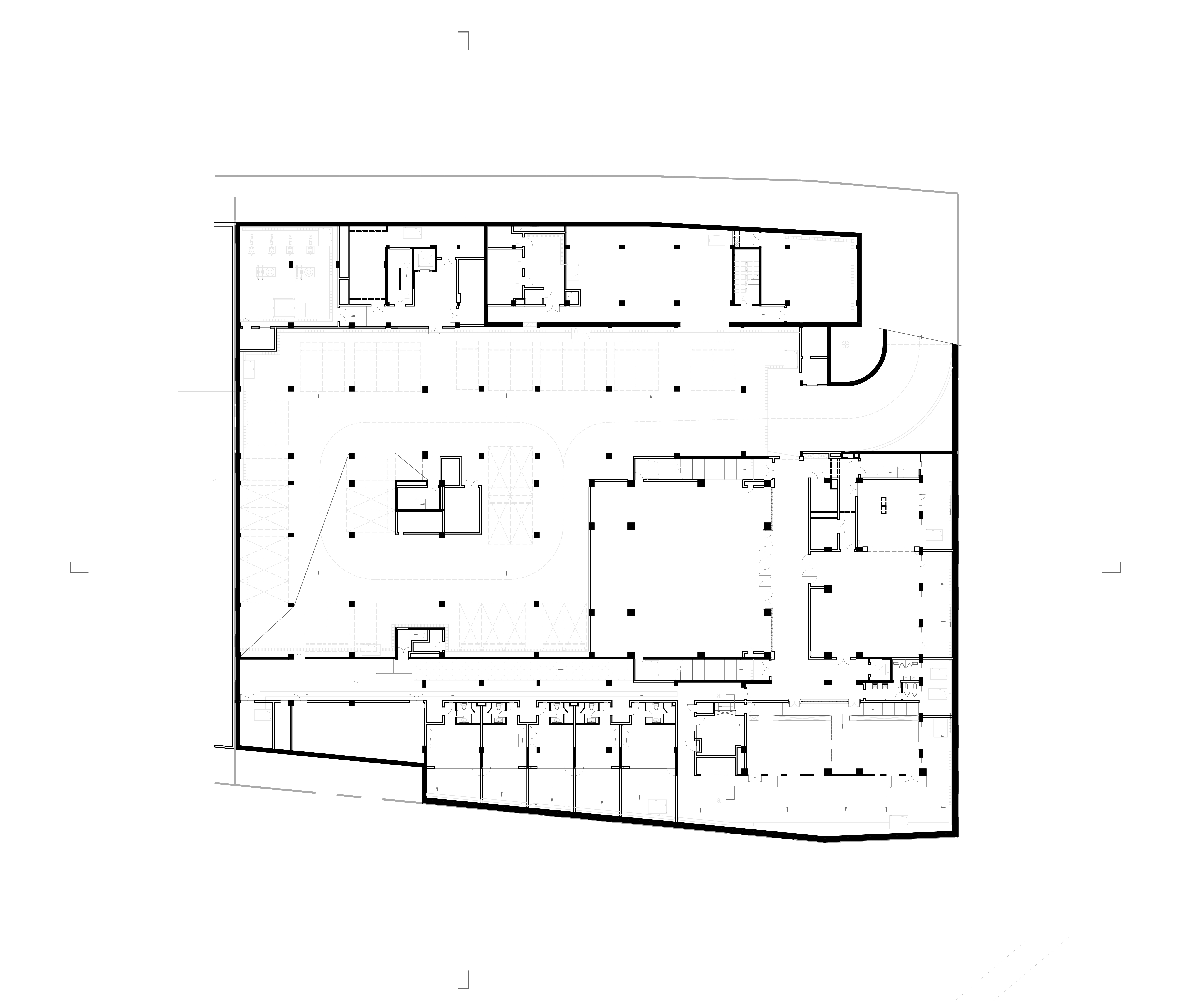

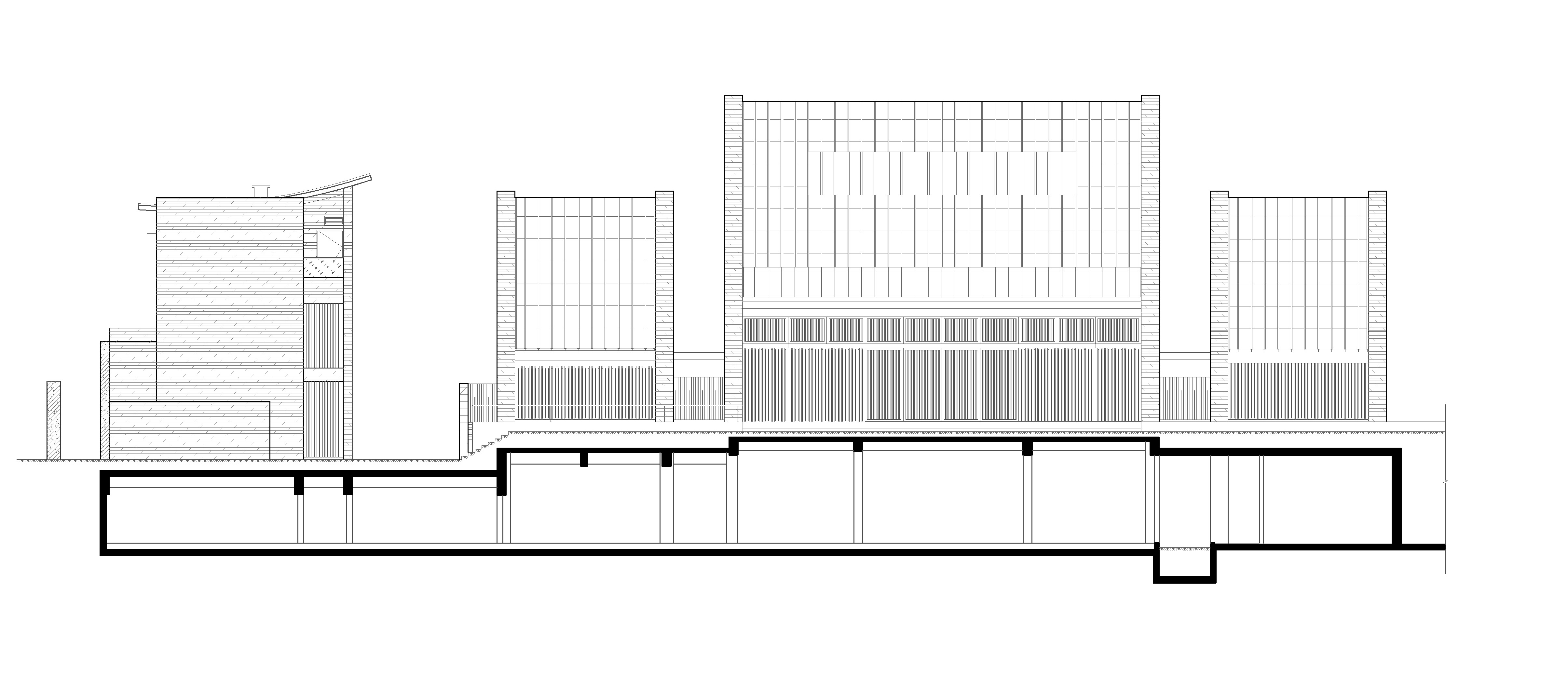
完整项目信息
项目名称:上海浦东国庆寺
项目地点:上海市浦东新区唐镇
设计时间:2014年—2016年
建成时间:2024年
业主:上海国庆寺
设计单位:深圳墨泰建筑设计与咨询有限公司
设计范围:建筑方案、施工图全程设计(含室内设计)
主持建筑师:沈驰
建筑:王淞、冯文清、刘为霞、朱维、刘余勇、伍玉聪、杨静、陈静儿、罗琼、王春燕、葛铁昶
结构:岑慧园、黄明星、陈惠明、甘凯、朱安安
电气:孙健有、吕珍地、李峰、潘志坚、高阳
给排水:李和、黄杰、温志军、李玲玲、张志华
暖通:彭天辉、代小山、张子星、唐丽华
室内:阮斌、唐韵珊、胡俊波、程翔、黄利波
无设建筑
景观:上海苗龙景观工程有限公司
摄影:TAL
奖项和荣誉:2024香港建筑师学会海峡两岸暨港澳建筑设计大奖银奖、第14届国际空间设计大奖艾特奖全球五强、2016深圳建筑创作奖金奖
版权声明:本文由深圳墨泰建筑设计与咨询有限公司授权发布。欢迎转发,禁止以有方编辑版本转载。
投稿邮箱:media@archiposition.com
pucpuggy
3个月前
回复